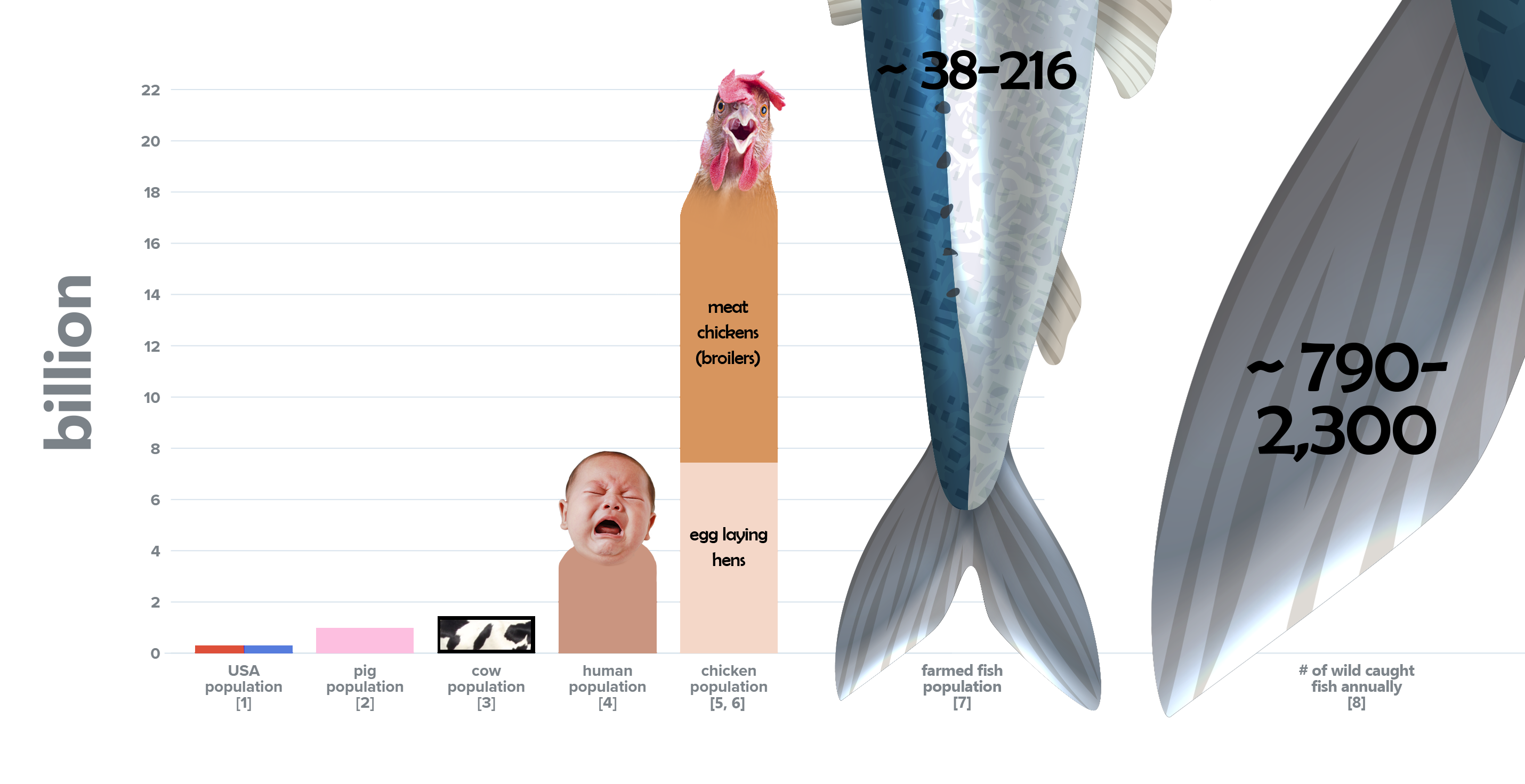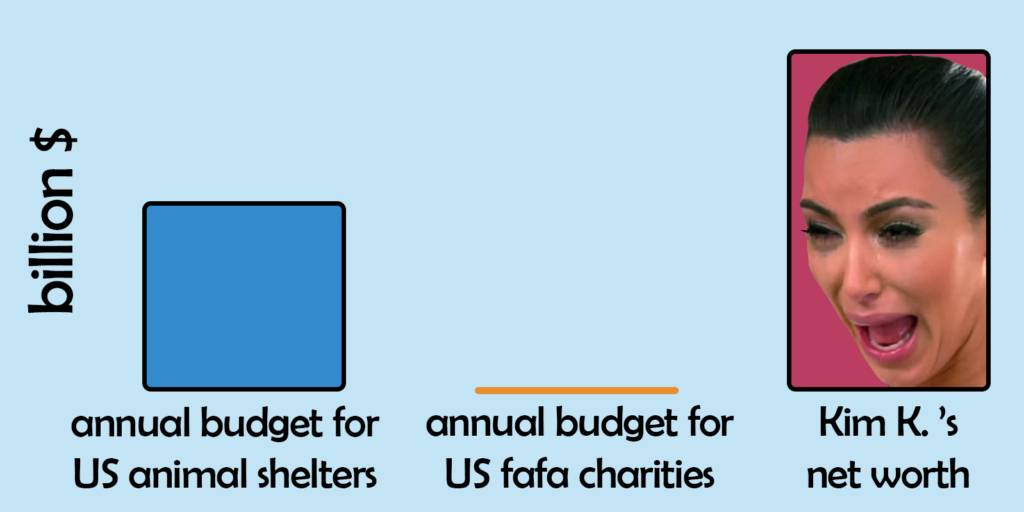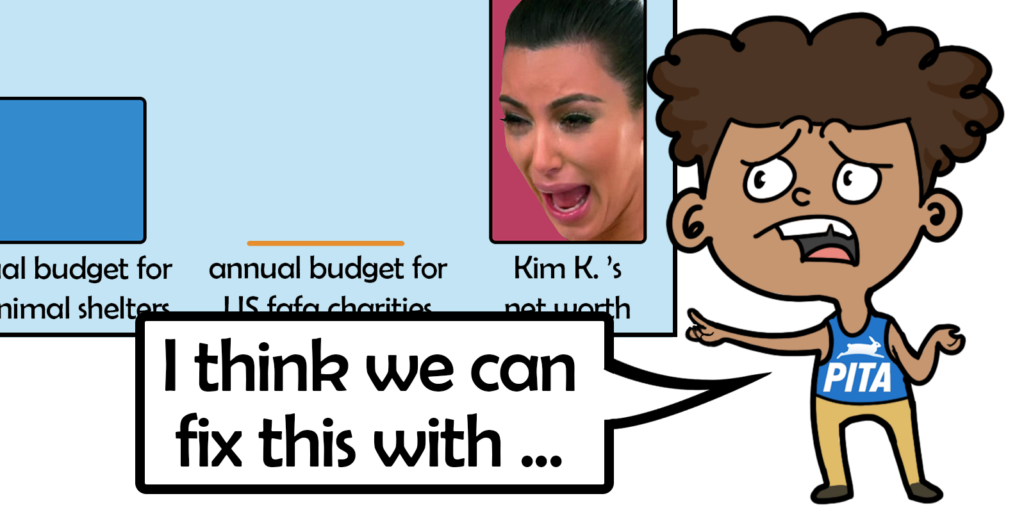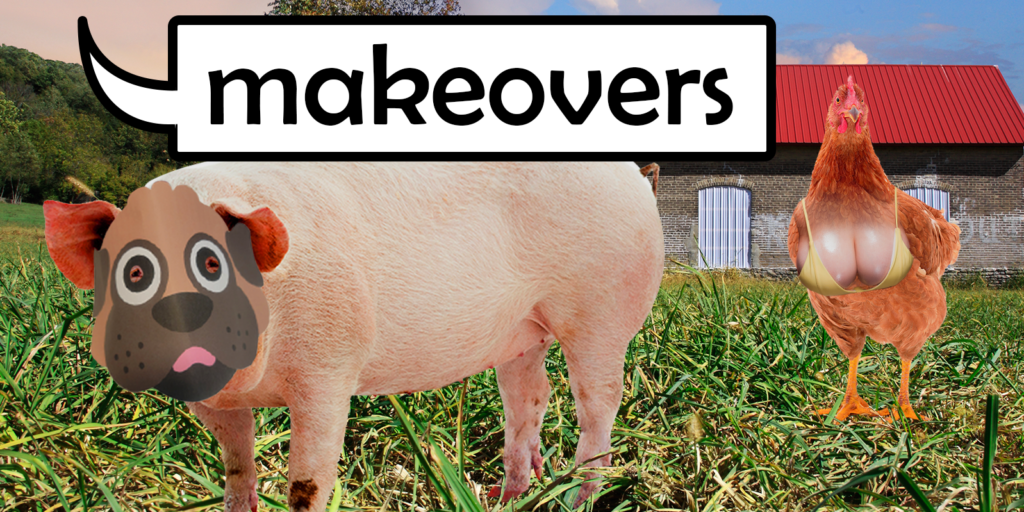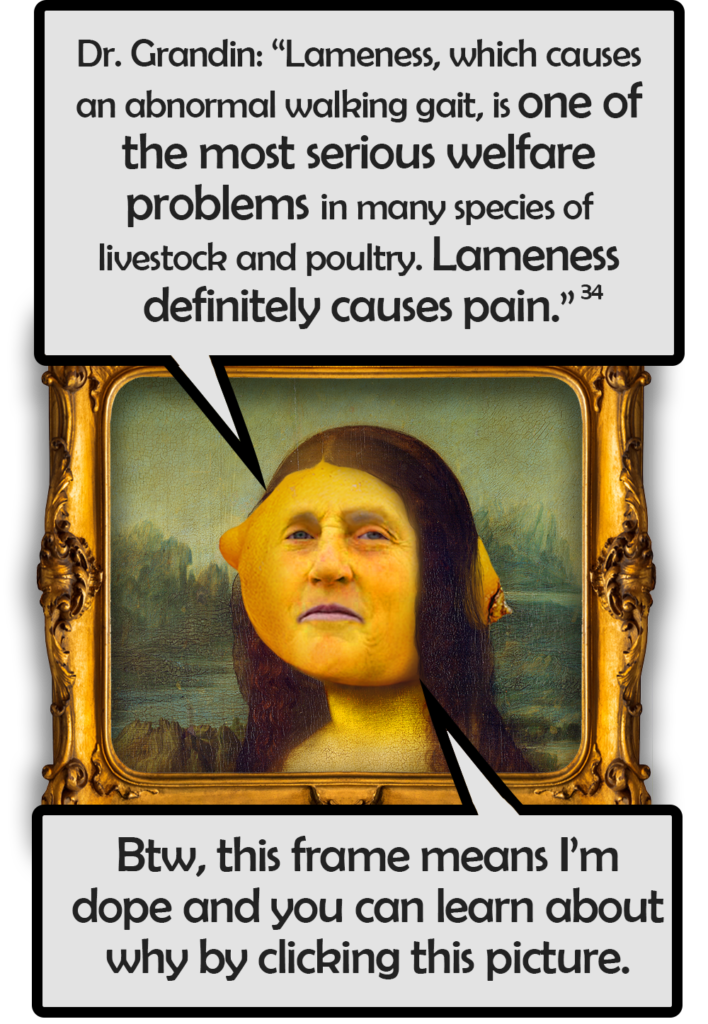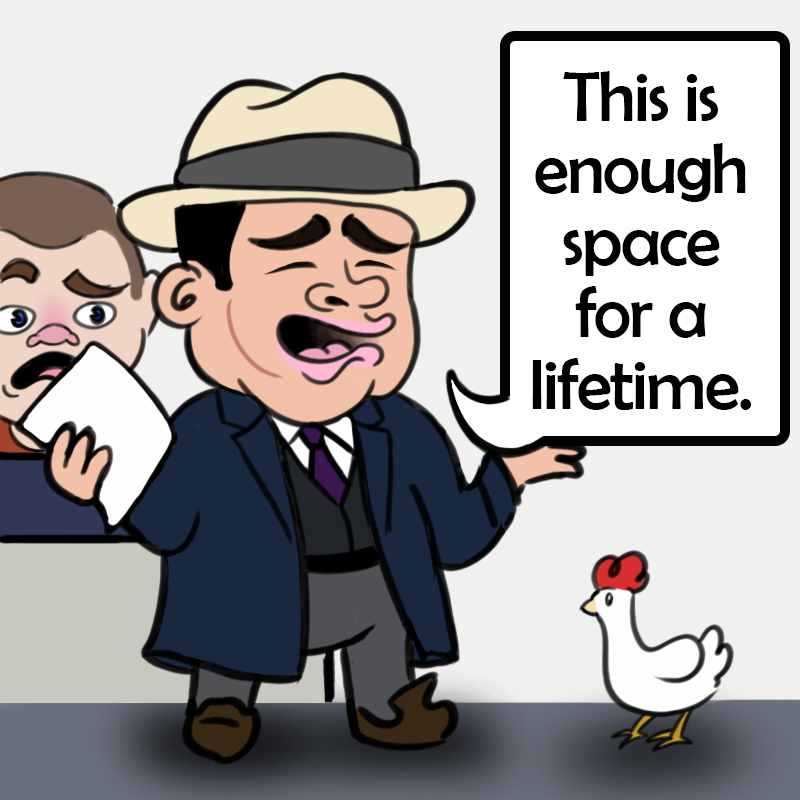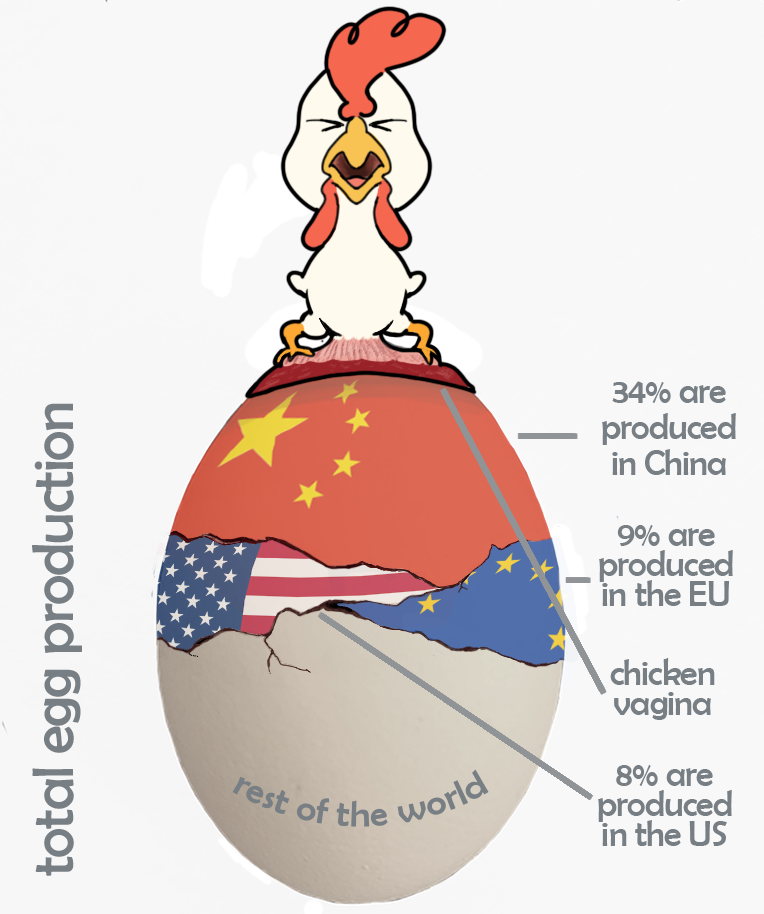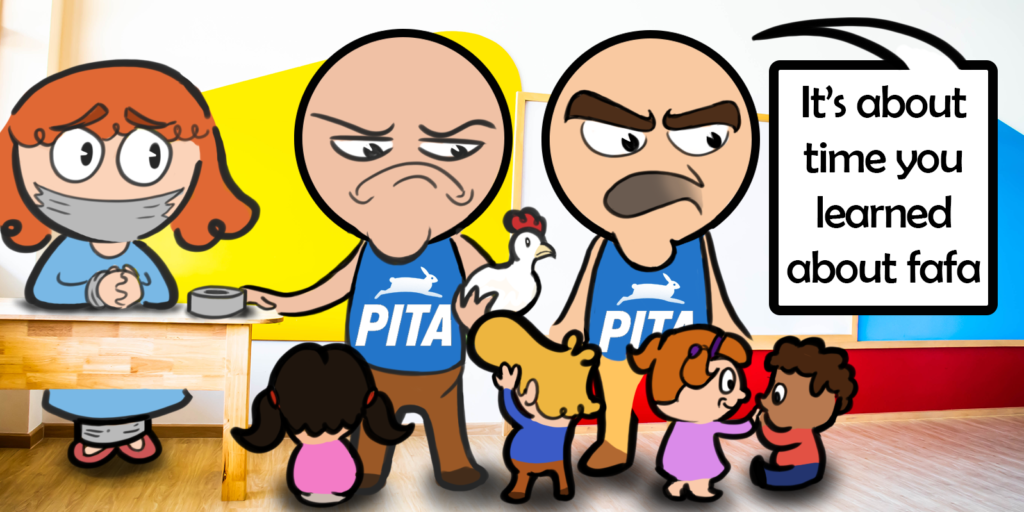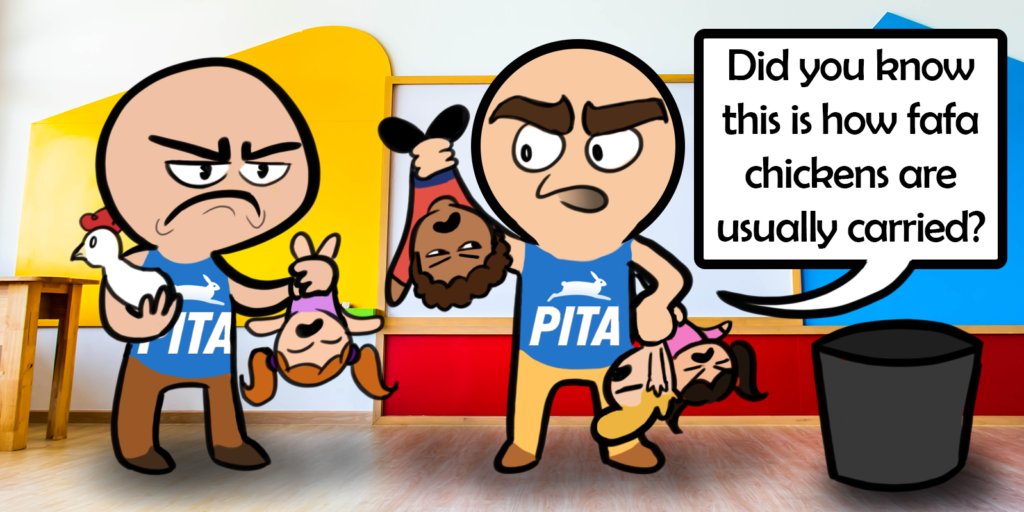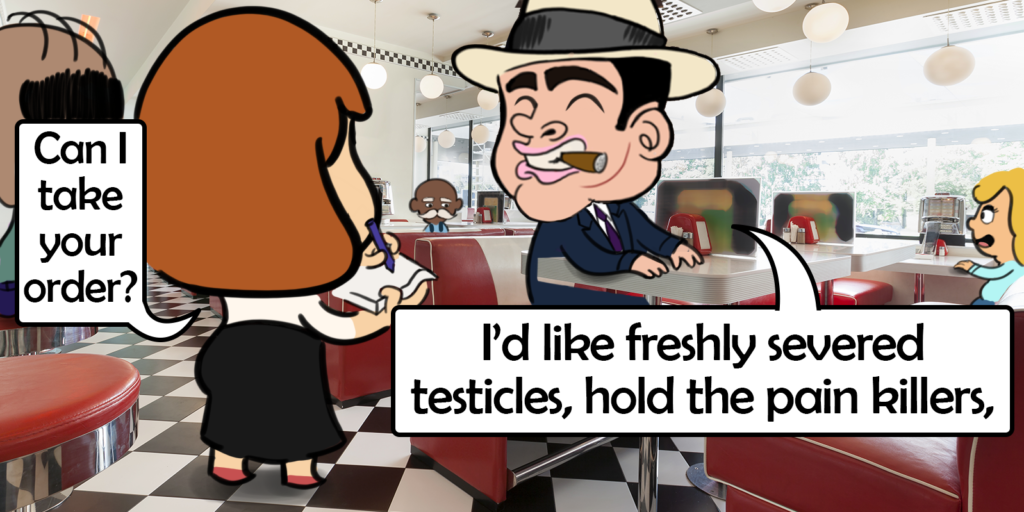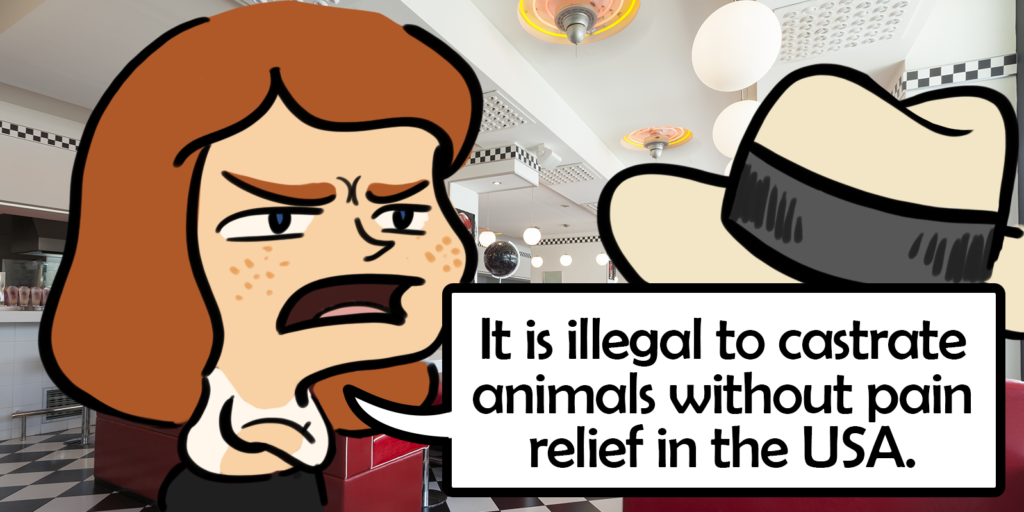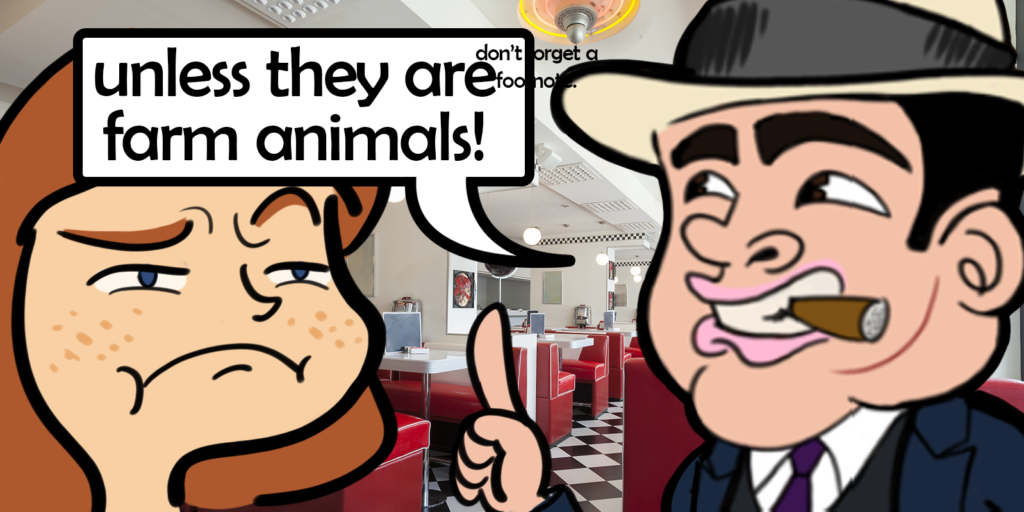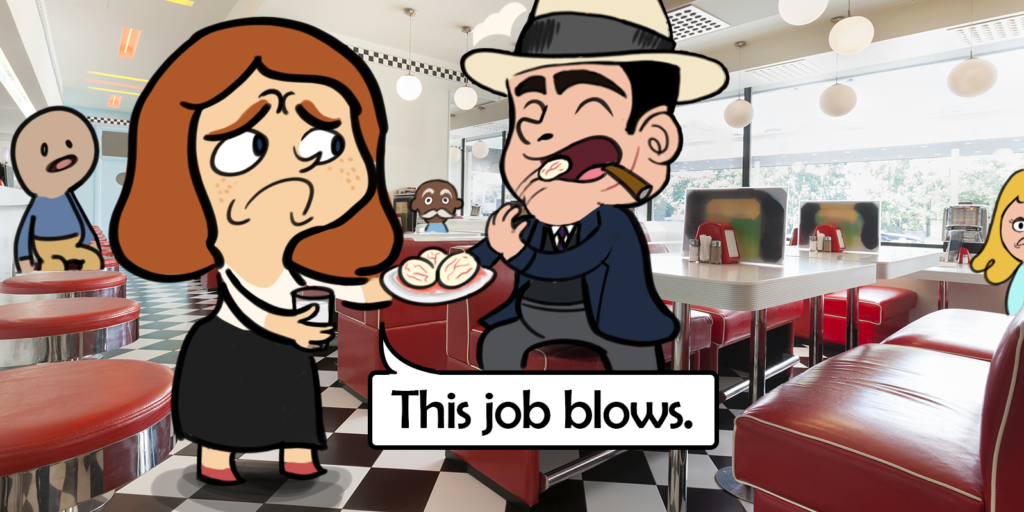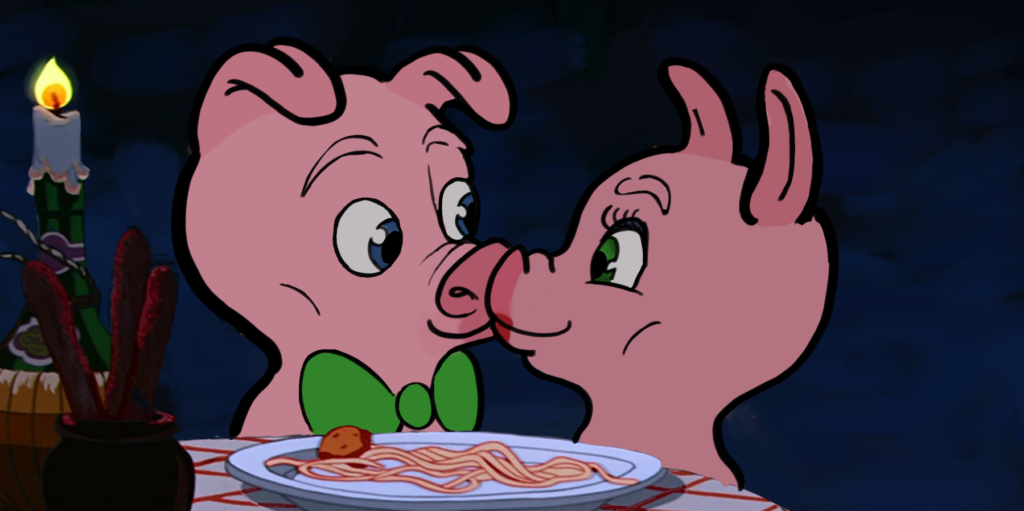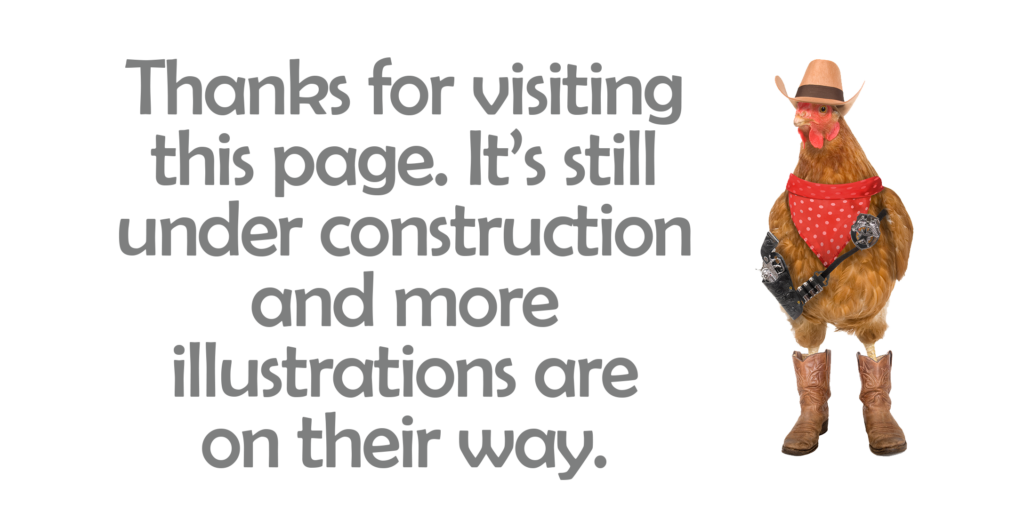
There once was a gangster named Al.
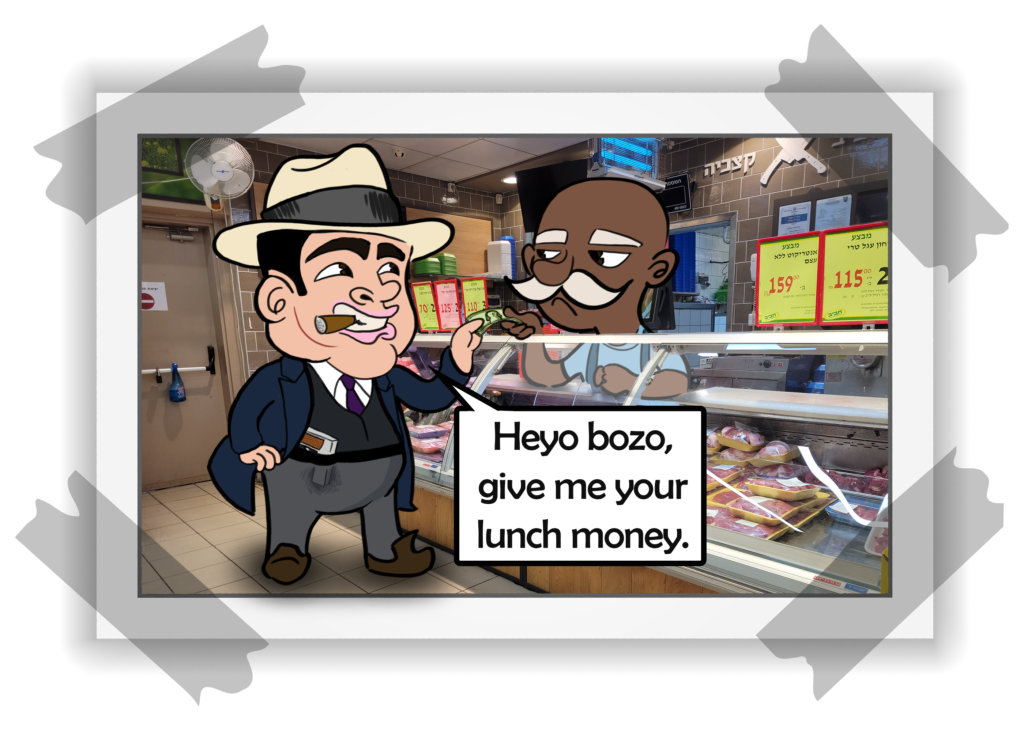
Al bullied people, abused animals, and was not nice to women.

That was the straw that broke the camel’s back and turned Al into a cow…
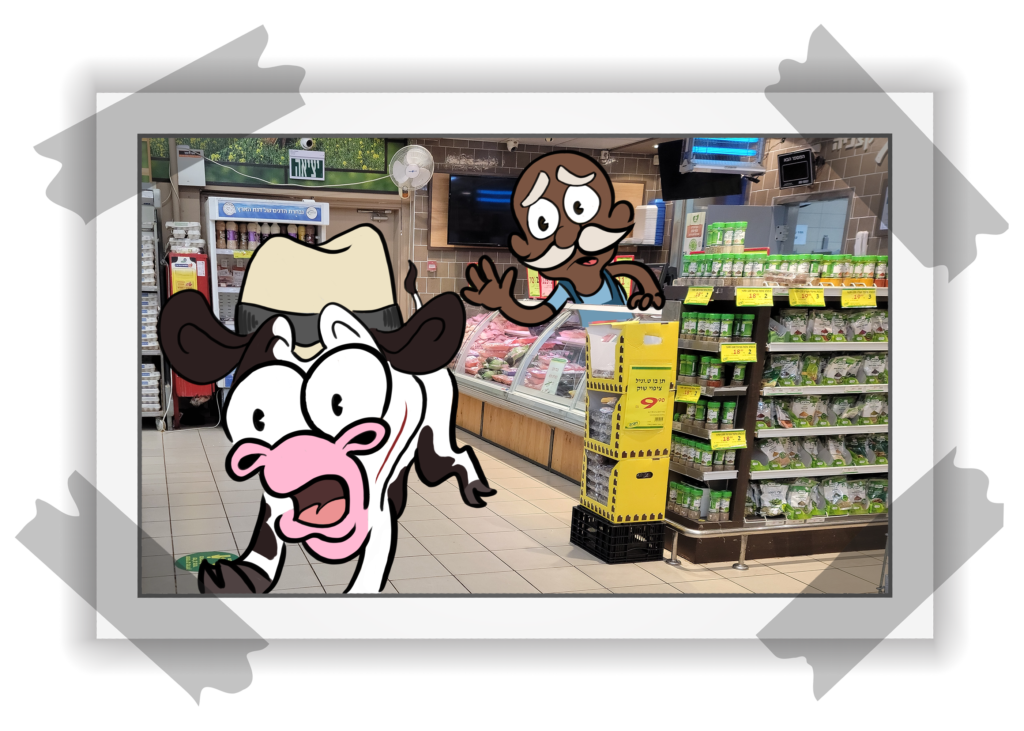
… until Al learned his lesson.
table of contents
1. al’s intro
2. mo money mo problems
3. don’t get me started on fish
4. fafa has done a number on chickens
5. farm animals go on the worst diets
6. a hen’s retirement
7. slaughterhouses’ mindboggling mistakes
8. a farm animal’s economy class
9. why fafas are madhouses
10. the worst threesome = Raw + routine + mutilations
11. the highlights of fafa life
12. fafa is more jam packed with pigs than Wall St.
13. fafas are the biggest cockblockers
14. fafas are the worst orphanages
15. lots of pain and grain
16. the bottom line
17. sources and footnotes

al’s intro
Heyo bozo. I’m a cow named Al and I made that graph to prove you’re lucky as fuck. Unlike you, most farm animals 9 gotta go through a factory farm, or what I call a fafa. Fafas are animal farms focused on “maximum production at minimum cost” 10 They’ve got a lot in common11 like stuffing lots of animal indoors. 10
I had to go through fafas and lots of the literature about them, and I’m not sure which was tougher. Lucky you don’t have to do either, because I don’t mind taking you on a brief tour of the most important issues for factory farmed animals, unless you’re a lil bitch.
mo money mo problems
Most experts agree that farm animals can feel pain 12 13 14 15 16 17 and that includes fish.18 19 20 Animals can be in pain even if they’re physically healthy and producing a lot of eggs, milk and meat. 22 23 24 25 Actually productivity and pain often go hand in hand.
Dr. Grandin, a prominent farm animal expert, says: “The biggest problem in many intensively raised animals is pushing the animal’s biology for more and more production. Breeders choose the most productive animals—the fastest growing, the heaviest, the best egg layers, and so on—and selectively breed just those animals. Bad things always happen when an animal is overselected for any single trait. Nature will give you a nasty surprise.” 26
For example, dairy cows today produce three to four times more milk than cows 60 years ago. 27 But back then, dairy cows could be productive for 10-15 years. 27 Now they usually live for 5 years 28 because that’s how long it takes for one to get used up.27 And in the meantime, they suffer from more leg problems (like lameness) and diseases (like mastitis). 29
Severe mastitis is one of the most painful conditions a cow can go through, but even mild cases hurt.30 And it’s the most common dairy cow disease in the world, 31 afflicting about 1 in 4 American dairy cows.32 1 in 4 are also chronically lame 33 which might not lessen milk production but causes plenty of pain. 34
And, please…
don’t get me started on fish
The “number of fish killed by people each year far exceeds the number of people who have ever existed on Earth”.35 I won’t go into how they are killed here because I don’t want to depress the 💩 out of you. So, I’ll just say it’s almost always inhumane36 37 and you can find out more about it in the footnotes.38
The craziest thing about wild caught fish is that they might be the lucky ones. Fish farming is also known as aquaculture and it’s pretty much hopeless. A recent review concluded that almost no fish farms could meet even the basic needs of fish without serious selective breeding.39
But so far, fish breeding has been focused almost exclusively on making the fish produce more rather than feel better.40 I have to hold myself back from saying more about fish because their domestication is relatively new, and their needs are more uncertain than farm animals that live on land. 41 42 And because fafas’ treatment of land animals is enough to illustrate the bigger picture of how they tend to “maximize production and minimal cost”.10
For example…
fafa has done a number on chickens
About 60 years ago chickens gained weight about 4x slower than chickens raised for meat today.43 In general the faster chickens grow, the more they suffer from disease, brittle bones, and skeletal deformities.44 Many of these problems are painful.45 It’s hard to know exactly how many chickens suffer from these problems but they are common enough that ~1/20 chickens made for meat (aka broilers) are unfit to survive just a month or two in a safe, sheltered, American fafa.46
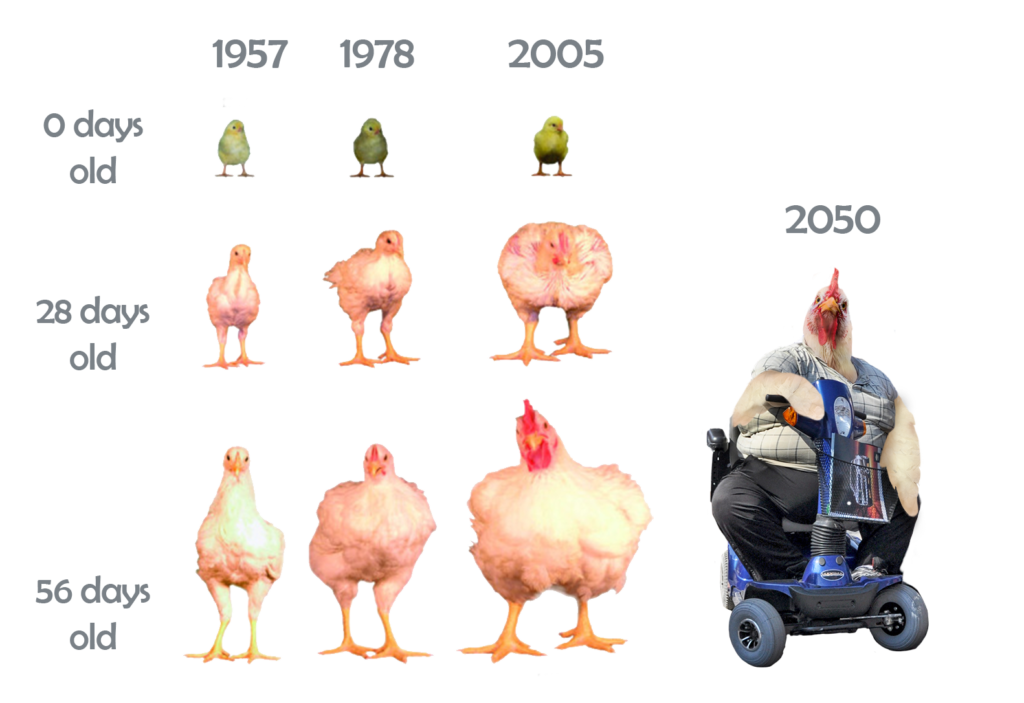
Broilers get fat fast, because they have been bred to have insane appetites that drive them to eat over 50 times a day.47 They get their gluttony from their parents (aka broiler breeders), who want to eat just as much, but can’t.
farm animals go on the worst diets
If broiler breeders ate until they were satisfied, they would quickly become dangerously obese and bad at reproducing. So instead, broiler breeders are regularly and severely starved. Sometimes they may only receive a fourth of how much they want.48 It is clear to experts (and probably most other people) that this causes the mother hens a great deal of pain.49 50
Mother pigs also suffer from a similar problem with similarly unsurprising results.51 52 And fafas aren’t above starving animals that aren’t overly hungry either. Hens naturally start laying less eggs after about a year53, so many producers will try to jolt their systems by starving them for 10-14 days (among other things).54 55 The practice is called forced/induced molting and if it doesn’t kill the hens, they’ll pump out more eggs. But it often kills them and always make them suffer.56
If you think that’s not good, you’re not the only one.57 Forced molting is outlawed in some regions, but enforcement is lacking so these bans may be disregarded even where they exist.58 59 And forced molting is still easy, cheap,55 and legal in most places such as China, which produces by far the most eggs60 and where the practice is currently widespread.61
a hen’s retirement
Believe it or not, that’s probably “not even the most serious welfare problem confronting the poultry industry”, according to Dr. Grandin.62 With or without forced molting, hens cannot lay eggs forever and when they are used up, they are worse than worthless. Their meat is unwanted,63 64 and they are taking up space that can be used for a new generation of productive egg layers.
Many slaughter plants don’t accept spent hens and killing them humanely is expensive.65 Therefore if they are transported to a slaughterhouse, it will be a long trip filled with many broken bones due to rough handling (often by exploited and overworked employees)66 and brittle bones (thanks to our old friend genetics).67 68 Surveys from the US and UK found that around 30% of them arrived at the slaughterhouse with broken bones.69 70
But on the farm the hens are usually disposed of by “But on the farm the hens are usually disposed of by “methods that range from atrocious to barely acceptable”.26 Examples include tossing live hens into dumpsters, thrusting them into woodchippers, or burying them alive.71
slaughterhouses make many mindboggling mistakes
But believe it or not, I think that’s not even the worst thing that poultry might endure. They are supposed to be dead, or at least unconscious, by the time their bodies are submerged in scalding water designed to loosen feathers72 or hairs. Similarly, cows aren’t supposed to be conscious when they are cut into pieces,73 but fafas often don’t work like they’re supposed to.
There’s no precise data on how often farm animals are conscious when they are torn apart or drowned in piping hot water, but it’s way more than never. The US Department of Agriculture (USDA) reports many recent cases of the latter happening to chickens on American slaughter plants, and their records are very probably far from complete.74 However, the USDA estimated that every year about a million chickens and turkeys are practically boiled while conscious in just the USA.75 Others estimate 1-3 million annually though the “real figure might be much higher”.76
The worst part is that it’s almost guaranteed to keep happening under current conditions of industrial slaughterhouses.77 78 79 80 For example:
- “The combination of line speeds that have increased as much as 800 percent in the past hundred years and poorly trained workers laboring under nightmarish conditions guarantees mistakes. (Slaughterhouse workers have the highest injury rate of any job — 27 percent annually — and receive low pay to kill as many as 2,050 cattle a shift.)”81
- The average American poultry slaughter plant keeps “unskilled, low-paid workers doing dirty, bloody work, often in stifling heat, under constant pressure to keep the killing lines moving no matter what so that they can slaughter up to 90,000 animals every shift.82
- Even if workers were perfect, reliably knocking the animals unconscious before slaughter often risks damaging their meat. Damaged meat is harder for fafas to sell and their interests often outweigh the animals’.83 84
Although sadistic abuses at slaughterhouses have been documented and don’t seem rare85 86 I bet most meat packers are good people and not the root of the problem. Just like I wouldn’t blame most surgeons for messing up if hospitals only gave them 100s of patients every hour, paid them 10x less, and made them work in slaughter plants.
a farm animals’s economy class
Regardless of what death is like, most animals are moved by trucks beforehand. It’s called “live transport”, and it’s a major source of stress for all farm animals87 88 because they aren’t used to riding in vehicles. Not to mention the vehicle they’re stuffed into is the opposite of luxurious. So the passengers can get overheated, starved, and trampled.89 90 91
In general, the longer the trip is, the more dangerous it becomes.92 93 However, sometimes longer trips are more profitable. 94 95 96 So, although it may take days or weeks, about two billion animals are internationally transported annually.97
why fafas are madhouses
If these facts are driving you nuts, you’re not alone. Animals on fafas often act crazy too. Some act out in weird but mostly harmless ways like chewing on their cages and drinking urine.98 99 Others lash out in destructive ways like pigs biting the tails of their pen mates or hens pecking their neighbors.
Either way, abnormal behavior has long been recognized as a strong sign that an animal is unwell.100 101 102 And it’s not hard to figure out why:
- Fafas are usually boring and barren.103104
- They don’t have to be so bad as you’ll see below, but for now they often don’t let animals act on most of their needs except eating, sleeping, and pooping.104 105
- Factory farmed animals are curious creatures106107108109110 with plenty of needs aside from those.
- For example, it’s real important to mother chickens and pigs that they can lay eggs or give birth in secluded spots a lot like a nest.111 112 113 114 And u can’t blame them, because newborn piglets and chicks are very weak and vulnerable. Of course, motherly instincts don’t just go away just because they’re in an indoor factory.115
- When animals can’t do things that are important to them, they feel like 💩.116
- Eating and pooping isn’t enough to satisfy them. And as we saw above, a lot of them don’t even get enough food.
Fafas can’t just ignore these facts because they sometimes result in behaviors toxic enough to cut into profits. They aren’t inevitable, and a lot of them can be remedied by sprucing up fafas a bit.117 118 119 120 121 For example, chickens can be given nest boxes which give them a bit of much needed privacy during egg laying.
Nest boxes are a good example of animal furniture which the pros call environmental enrichments.122 If pigs are given environmental enrichment, they do a lot less tail biting. And it’s obvious it also helps if animals are bred for traits aside from productivity.123 124 125 126 127
And if they are also raised in natural environments, you can forget about excessive feather pecking and tail biting.128 129 130 That’s probably why some experts believe these behaviors usually aren’t aggressive. According to them, they are probably just what happens when you don’t give these mentally starving animals anything better to do than explore their bodies.106 131 132
But most farm animals don’t have any other option. Only four out of the 150 of the world’s largest food companies have committed to providing environmental enrichments (aka animal furniture) to all the animals under their care.133 So at any given time most laying hens, about 4.5 billion of them, crammed into battery cages without nest boxes.134 135 136
Most pigs don’t get nearly enough enrichments either. China is the world’s largest pork producer and has laws that get in the way of giving them proper enrichments.137 The US is the world’s second largest producer of pork and it’s uncommon to give pigs enrichments there too.138
raw + routine + mutilation = the worst kind of threesome
So you’ll probably never guess which solution most* fafas use to prevent animals from hurting themselves, because it’s none of the above.
- *To be fair, the EU has mandated that all laying hens have access to nests and pigs have access to enrichments.139 140 But most hens and pigs aren’t in the EU and even in the EU lots of producers don’t give pigs what the law requires.141 142 143
None of the above is cheaper than simply mutilating the animals so they can’t mutilate each other as much. Especially since fafas almost never bother to apply pain relief.144 145 So pigs have the ends of their tails sliced off, and billions of bird’s beaks are blunted, even though it’s widely accepted that’s painful.146 147 148 149 150 151
Even though that doesn’t treat the root of the problem and relieve any mental suffering.152 153 Even though applying local anesthetics is usually cheap, simple, and effective.154 155 156 And even though fafas are already cutting costs by doing virtually all other routine surgeries, like castration,157 without anesthetics.144 145 146
the highlights of fafa life
It’s hard to bounce back from castration without pain relief and fafas don’t even try. None of the world’s largest 150 food companies report on any signs that animals are enjoying themselves,158 and I’m pretty sure they wouldn’t keep this data to themselves if it existed. Still, it’s not too hard to figure out how good life gets for a factory farmed animal.
Land farm animals enjoy basically the same six things: acting natural 159 [#1] and playing [#2] with family [#3] and friends [#4] in interesting [#5] and spacious places. [#6] 160 161 Most fafas provide exactly 0/6 ingredients for a happy life.
fafas are more jam packed with pigs than Wall St.
#6- Not spacious places: Fafas are a lot of things, but spacious is not one of them.162 163
#4 Unfriendly places: Fafas like to pack chickens and pigs so tight they have a hard time making friends or getting comfy.104 164 165 166 For example, chickens like to live with about a dozen others.167 But in the US they are usually stuffed into sheds with 20,000 others, each given about a paper’s worth of personal space.168 At these densities they sure show signs of stress like dying more often.166
Pigs aren’t much luckier. They also like living in small groups and instinctually feel threatened by intruders.169 When outsiders are put into a group (and not allowed to retreat), serious fighting is almost inevitable.170 Which is why it’s not very nice that groups of pigs are usually mixed up several times in their lives.171 172
fafas are the biggest cockblockers
Unnatural places (#1) and Uninteresting places (#5): Fafas are unnatural by any definition and only interesting to sadists. Animals aren’t allowed to enjoy themselves even when it’s free.
For example, land farm animals probably love making love173 174 but that’s too wasteful for fafas. Instead, they collect sperm directly from the males (usually with not much more than a gloved hand for pigs)175 176 and squirt the minimum amount of it inside the ladies.
- Sidenote: “Artificial insemination is a clinical and detached term for a practice that involves invasive and sustained bodily contact between humans and animals… Pig production textbooks refer to all this extensive human-animal contact unironically as a ‘courtship.’”177
It’s called artificial insemination, and it’s fafa’s favorite way of breeding livestock that live on land (except chickens (for now))178. Between 80-100% of turkeys, dairy cattle, and pigs in North America and Europe are artificially inseminated and it’s becoming increasingly popular with other animals too.178
Most chickens don’t get to get lucky either, because most chickens are slaughtered before they reach sexual maturity.179 Laying hens live longer but are kept in groups of females which is bound to rain on their parades. Although this taco fest sounds like it would be paradise for males, it turns out to be the opposite.
fafas are the worst orphanages
That’s because different breeds of chickens are used for meat and egg laying. So, if a layer hen gives birth to a boy (which happens about half the time) he isn’t worth raising for his meat and he sure can’t lay eggs. So, these guys are killed right after being born, usually by being gassed or shredded.180
#3- Not family friendly: No matter what a breeder animal has to go through, she probably won’t get to enjoy motherhood for long. In general, the sooner moms are separated from their kids, the more money you can make from moms181 so babies are significantly or completely deprived of maternal care.182 183 184
Cows really don’t appreciate this. Mother and calf are usually separated right after birth.185 This can cause the moms to mope and bellow for days and cause the calves so much stress they get physically sicker.186 187
lots of pain and grain
But on the bright side farm animals are usually well fed unless they commit the crimes of giving birth or laying eggs. Or being a cow, because they are usually fattened up on grains, mostly corn, for about half a year before being slaughtered.188
It’s obvious cows are supposed to eat grass, not corn, because grain makes cows sick to some extent. It can cause liver disease, death, and diarrhea189 which is what it tastes like to me. Though I can’t speak for other cattle or animals, I really doubt they are given any food tasty enough to outweigh the above, or even just castration without anesthetic.
In fact, all the above is a party pooper because animals find it hard for them to enjoy themselves and play (#2) when they are suffering190 191 192
the bottom line
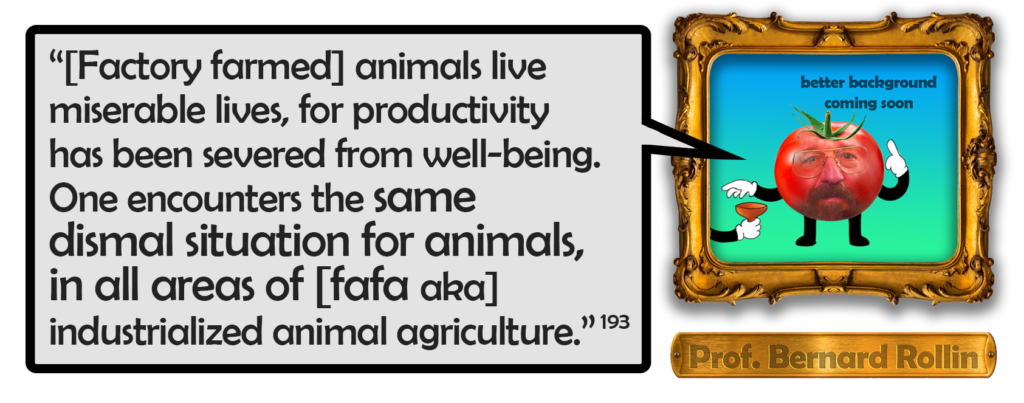
Did you know that the average human thinks their life is about halfway between the worst and best possible life (a 5 out of 10)?194 But as I’m sure you know, humans are in the minority because at this moment there are 7-30x more factory farmed animals than people.9
So if the average factory farmed animal suffers more than 1/7th as much as the average person, factory farmed animals would suffer more than all of humanity. And that doesn’t include the many billions, and maybe trillions, of fish also caught up in the system.195
I hope you’ve braced yourself because a lot of these problems are getting worse. Fafas keep popping up in poorer places196 that can’t afford to enforce animal welfare laws.197 But I’ve got hope cuz there’s people like you, reading articles like this, and learning about these issues. And there’s more198 but Piessiah is going to have to tell you about it, because I got to go expel grain.
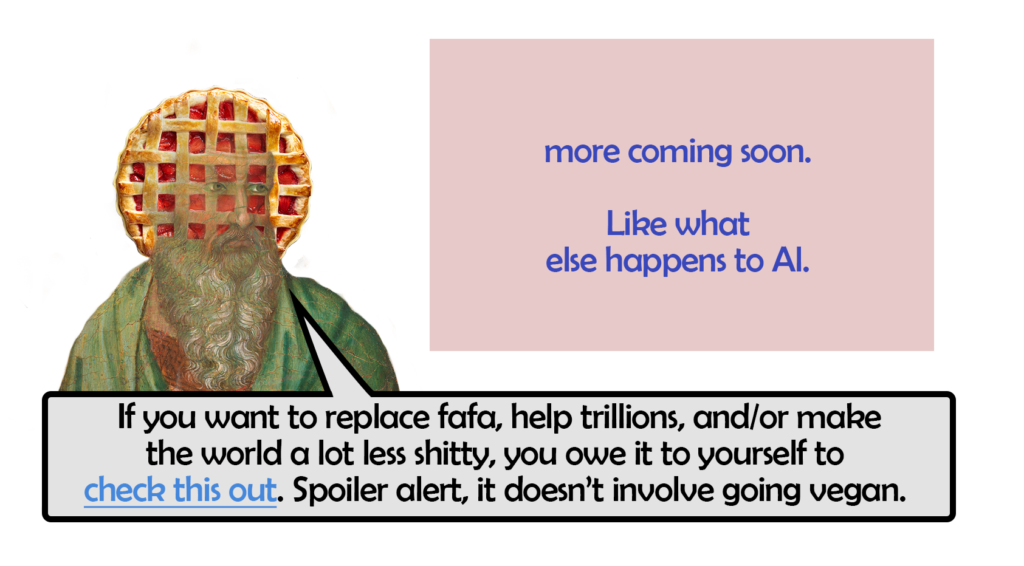
sources and footnotes
[1] “United States Population (LIVE).” Worldometer, www.worldometers.info/world-population/us-population/. Accessed June 10, 2021 [2] “Number of Pigs.” Our World in Data, ourworldindata.org/grapher/pig-livestock-count-heads?tab=table+s. Accessed June 10, 2021 [3] “Number of Cattle.” Our World in Data, ourworldindata.org/grapher/cattle-livestock-count-heads?tab=table. Accessed June 10, 2021 [4] “Current World Population.” Worldometer, www.worldometers.info/world-population/. Accessed June 10, 2021 [5] Bennett, Carys E., et al. “The Broiler Chicken as a Signal of a Human Reconfigured Biosphere.” Royal Society Open Science, vol. 5, no. 12, 2018, p. 180325., doi:10.1098/rsos.180325. [6] “It is estimated that there are 7.47 billion egglaying hens in the world.”– Compassion in World Farming, 2020, EggTrack 2020 Report, www.ciwf.com/media/7442448/2020-eggtrack-report-english.pdf. p. 11
[7] The Sentience Institute estimates that “38.8 to 215.9 billion fish are being farmed globally at any given time– Anthis, Kelly. “Global Farmed & Factory Farmed Animals Estimates.” Sentience Institute, Sentience Institute, 19 Feb. 2019, www.sentienceinstitute.org/global-animal-farming-estimates. Accessed 03 June 2021.
[8] It has been estimated (in 2019) that between 0.79 and 2.3 trillion fish (ie 790,000,000,000 to 2,300,000,000,000) were caught from the wild globally each year for 2007-2016.”- Numbers of Fish Caught from the Wild Each Year, fishcount.org.uk/fish-count-estimates-2/numbers-of-fish-caught-from-the-wild-each-year.
– Anthis, Kelly. “Global Farmed & Factory Farmed Animals Estimates.” Sentience Institute, Sentience Institute, 19 Feb. 2019, www.sentienceinstitute.org/global-animal-farming-estimates. Accessed 03 June 2021.
That would mean 38.8-215.9 billion fish and 22.94 (31 x .74) billion land or 61.74-238.34 billion farm animals in total are “living in factory farms at present.”
[10] Merriam Webster dictionary defines factory farms as “a large industrialized farm especially: a farm on which large numbers of livestock are raised indoors in conditions intended to maximize production at minimal cost”
– “Factory Farm.” Merriam-Webster, Merriam-Webster, www.merriam-webster.com/dictionary/factory%20farm. Accessed 01 March 2021.
Similarly Cambridge Dictionary Online defines “factory farming” as “a system of farming in which a lot of animals are kept in a small enclosed area, in order to produce a large amount of meat, eggs, or milk as cheaply as possible.”
- “Factory Farming.” FACTORY FARMING | Definition in the Cambridge English Dictionary, dictionary.cambridge.org/us/dictionary/english/factory-farming. Accessed 01 March 2021.
[11] “This industrial model goes by a number of names, including ‘industrial animal agriculture,’ ‘industrial farm animal production’ (IFAP), ‘industrial animal production’ (IAP) and, more colloquially, ‘factory farming’; herein we use the term IFAP. IFAP is characterized by corporate ownership and/or control; economic consolidation and vertical integration; the extreme confinement of large numbers of animals; the use of “technological sanders” (Rollin 2001) such as growth-promoting antibiotics; the use and long-distance transport of remotely-grown concentrated feedstuffs, instead of forage- or pasture-based feeding; and tight control over the breeding, feeding and living conditions of animals so as to achieve the greatest production at the lowest cost and in the shortest amount of time…
IFAP can be defined in terms of both logic and practice. Fitzgerald (2003) identifies five components that are definitive of industrialization, including ‘large-scale production, specialized machines, standardization of processes and products, reliance on managerial (rather than artisanal) expertise, and a continual evocation of ‘efficiency’ as a production mandate’ (p. 23). As applied to animal agriculture, this industrialization has resulted in a number of hallmark features”
- Rossi, J., Garner, S.A. Industrial Farm Animal Production: A Comprehensive Moral Critique. J Agric Environ Ethics 27, 479–522 (2014). https://doi.org/10.1007/s10806-014-9497-8
[12] Dr. Temple Grandin writes: “There are numerous scientific studies, review papers, and books which document that livestock and poultry feel both pain and fear.”
- Grandin, Temple. Ch. 2 of Improving Animal Welfare a Practical Approach, edited by Temple Grandin, 2nd ed. CABI (CABI International), 2015.
[13] Farm animals are sentient beings, which mean they have feelings and emotions. As a result, they can suffer fear and pain, but also experience pleasure and happiness.”
- Oscar Madzingira (September 26th 2018). Animal Welfare Considerations in Food-Producing Animals, Animal Welfare, Muhammad Abubakar and Shumaila Manzoor, IntechOpen, DOI: 10.5772/intechopen.78223. Available from: https://www.intechopen.com/books/animal-welfare/animal-welfare-considerations-in-food-producing-animals
[14] “The general consensus among both scientists and philosophers is that when it comes to pain, the higher animals are wired much like we are for the same evolutionary reasons”
- “The Ethics Of Eating Animals.” The Omnivore’s Dilemma: a Natural History of Four Meals, by Michael Pollan, Penguin Books, 2016, archive.org/stream/Michael_Pollan-The_Omnivores_Dilemma/Michael_Pollan-The_Omnivores_Dilemma_djvu.txt.
[15] The influential Brambell Committee stated:
It is “justifiable to assume that the sufferings of animals [in context they are talking about domestic mammals and birds, not all animals] are not identical with those of human beings; it is equally justifiable to assume that they suffer in similar ways;”
and
“We accept that although pain, suffering and stress are certainly not identical in animals and men, there are sound reasons for believing that they are substantial in domestic animals and that there is no justification for disregarding them… We accept that animals can experience emotions such as rage, fear, apprehension, frustration and pleasure”
- Rogers Brambell, F.W. 1967, p. 9-10, Report of the Technical Committee to Enquire into the Welfare of Animals Kept under Intensive Livestock Husbandry Systems. Available at: https://edepot.wur.nl/134379. Accessed 01 March 2021.
[16] “In a more systematic survey of British scientists, all but two of 155 animal researchers said that animals experienced pain.”
- Ch. 8. Some We Love, Some We Hate, Some We Eat Why It’s so Hard to Think Straight about Animals, by Hal Herzog, Harper Perennial, 2011.
[17] “Arguably the greatest skeptic in the history of philosophy, who denied the ultimate knowability of mind, body, God, causation, the past, and the future, Hume nonetheless extended no doubt to the animal mind.” He asserted ‘few things are as obvious as the fact that animals have thoughts and feelings and that this point does not escape ‘even the most stupid.’”
- Rollin, Bernard E. Putting the Horse before Descartes: My Life’s Work on Behalf of Animals. Temple University Press, 2011.
[18] ”The opinion that fish, and some invertebrates such as decapods and cephalopods, can experience pain and suffering was adopted by the European Food Safety Authority in 2009 (EFSA, 2009)”
- Howard I Browman, et. al: Welfare of aquatic animals: where things are, where they are going, and what it means for research, aquaculture, recreational angling, and commercial fishing, ICES Journal of Marine Science, Volume 76, Issue 1, January-February 2019, Pages 82–92, https://doi.org/10.1093/icesjms/fsy067
[19] The American Veterinary Medical association wrote that when it comes to euthanasia “the preponderance of accumulated evidence supports the position that finfish should be accorded the same considerations as terrestrial vertebrates in regard to relief from pain.’’
- AVMA Guidelines for the Euthanasia of Animals 2020 Edition. Accessible at https://www.avma.org/sites/default/files/2020-02/Guidelines-on-Euthanasia-2020.pdf
[20] ”Even now, with a broad scientific consensus that fish are sentient (3) and have the capacity to suffer, there is little evidence of improvement in slaughter methods on the majority of fish farms around the world’’
- Lines, J.A., and J. Spence. “Humane Harvesting and Slaughter of Farmed Fish.” Revue Scientifique Et Technique De L’OIE, vol. 33, no. 1, 2014, pp. 255–264., https://doi.org/10.20506/rst.33.1.2284. Accessible at https://doc.oie.int/dyn/portal/index.xhtml?page=alo&aloId=31762
[21] Brown, Culum and Dorey, Catherine, Pain and Emotion in Fishes – Fish Welfare Implications for Fisheries and Aquaculture, Animal Studies Journal, 8(2), 2019, 175-201.
Available at: https://ro.uow.edu.au/asj/vol8/iss2/12
- Grandin, Temple. Ch. 2 of Improving Animal Welfare a Practical Approach, edited by Temple Grandin, 2nd ed. CABI (CABI International), 2015.
[23] “Even when all basic survival needs have been met and the intensities of the associated homeostasis-related negative affects are at low levels, situation-related negative affects may still arise (Mellor 2015a). These may include frustration, anger, boredom, depression, helplessness, loneliness and isolation, and may occur when animals are kept in impoverished environments, when nutrient-dense feeds are provided as small meals that are consumed rapidly, and when there is little or no access to the company of others”
- DJ Mellor (2015) Positive animal welfare states and encouraging environment-focused and animal-to-animal interactive behaviours, New Zealand Veterinary Journal, 63:1, 9-16, DOI: 10.1080/00480169.2014.926800
[24] “Equating productivity and welfare is, to some significant extent, legitimate [but that]… is not the case “under industrial conditions” that use “antibiotics, feed additives, hormones, air handling systems… without these technologies, the animals could not be productive”
- Rollin, Bernard. Ch. 3 of Improving Animal Welfare a Practical Approach, edited by Temple Grandin, 2nd ed. CABI (CABI International), 2015.
[25] “Many scientists agree that health and productivity are not the only factors for determining whether or not an animal has good welfare. There is increasing emphasis on assessing the emotional or affective state of the animal.”
- Lily N. Edwards-Callaway. Ch. 8 of Improving Animal Welfare a Practical Approach, edited by Temple Grandin, 2nd ed. CABI (CABI International), 2015.
[26] Ch. 7 of Animals Make Us Human: Creating the Best Life for Animals, by Temple Grandin and Catherine Johnson, Mariner Books, 2010.
[27] “Today’s dairy cow produces three to four times more milk than 60 years ago. In 1950, the average dairy cow annually produced 2410 l (5314 lb) of milk per lactation. Fifty years later, it was close to 9072 l (20,000 lb) (Blaney, 2002). From 1995 to 2004 alone, milk production per cow increased 16%. Today, the dairy cow has had further increases in milk production. This has resulted in an animal that is having greater and greater reproductive problems (Rodenburg and Turner, 2012). The result is a milkbag on legs, and unstable legs at that. A high percentage of the US dairy herd is chronically lame, and these cows suffer serious reproductive problems. Espejo et al. (2006) found that an average of 24.6% of dairy cows housed in cubicle (freestall) barns were lame. A more recent study showed that the average percentage of lame dairy cows was 28% (von Keyserlingk et al., 2012). Whereas, in traditional agriculture, a milk cow could remain productive for 10 and even 15 years, today’s cow lasts slightly longer than two lactations, a result of metabolic burnout and the quest for ever-increasingly productive animals”
- Rollin, Bernard. Ch. 3 of Improving Animal Welfare a Practical Approach, edited by Temple Grandin, 2nd ed. CABI (CABI International), 2015.
[28] “The Life Expectancy of Farm Animals.” FOUR PAWS in US, www.four-paws.us/campaigns-topics/topics/farm-animals/life-expectancy. Accessed 01 March 2021.
[29] Rodenburg, T.B., and S.P. Turner. “The Role of Breeding and Genetics in the Welfare of Farm Animals.” Animal Frontiers, vol. 2, no. 3, 2012, pp. 16–21., doi:10.2527/af.2012-0044.
[30] “Dairy producers and veterinarians consider severe cases of mastitis as one of the most painful conditions in dairy cows. However, it is well known that cows can also experience pain in mild or moderate cases of mastitis. Even subclinical mastitis is accompanied by increased levels of bradykinin, a peptide which mediates the inflammation related to mastitis.”
- Mainau, E., et al. Welfare Issues Related to Mastitis in Cows, 20 Oct. 2015, www.fawec.org/en/technical-documents-cattle/130-welfare-issues-related-to-mastitis-in-cows#:~:text=Mastitis%20is%20one%20of%20the,are%20still%20being%20currently%20reported.
[31] “Mastitis is the most widespread and costly disease in dairy cattle occurring throughout the world.”
- Abebe, R., Hatiya, H., Abera, M. et al. Bovine mastitis: prevalence, risk factors and isolation of Staphylococcus aureus in dairy herds at Hawassa milk shed, South Ethiopia. BMC Vet Res 12, 270 (2016). https://doi.org/10.1186/s12917-016-0905-3
[32] “In 2013, the most common clinical diseases in cows reported by [US dairy] producers were mastitis (24.8 percent of cows)”
- USDA. 2018. Dairy 2014, “Health and Management Practices on U.S. Dairy Operations, 2014” USDA–APHIS–VS–CEAH–NAHMS. Fort Collins, CO #696.0218 Available at: https://www.aphis.usda.gov/animal_health/nahms/dairy/downloads/dairy14/Dairy14_dr_PartIII.pdf
[33] A 2012 study found that “in Canada and the northern USA it [the average percentage of lame dairy cows] was over 27%. In England and Wales, the average percentage of lame dairy cows was 36.8%.”
- Grandin, Temple. Ch. 2 of Improving Animal Welfare a Practical Approach, edited by Temple Grandin, 2nd ed., CABI (CABI International), 2015.
[34] Grandin, Temple. Ch. 2 of Improving Animal Welfare a Practical Approach, edited by Temple Grandin, 2nd ed. CABI (CABI International), 2015.
[35] “an estimated 10 to 100 billion farmed fish are killed globally every year, and about another one to three trillion fish are caught from the wild. The number of fish killed each year far exceeds the number of people who have ever existed on Earth.”
- It’s Official: Fish Feel Pain.” Smithsonian.com, Smithsonian Institution, 8 Jan. 2018, www.smithsonianmag.com/science-nature/fish-feel-pain-180967764/.
[36] “the amount of money it would cost to humanely kill them all [wild-caught fish] would raise the price to ten times what we currently pay, according to Culum Brown, associate professor of vertebrate evolution and director of Higher Degree Research at Macquarie University”
- Ferguson, Cat, and Diana Marques. “How to Kill A Fish.” Topic, Topic, 22 May 2019, https://www.topic.com/how-to-kill-a-fish.
[37] ““There are serious practical difficulties involved in catching fish without suffering. Genuinely humane slaughter may be unachievable.”
- Mood, Alison. “ Worse Things Happen at Sea: the Welfare of Wild-Caught Fish.” Http://Fishcount.org.uk/, 2010, http://www.fishcount.org.uk/published/standard/fishcountfullrptSR.pdf.
[38] “there is no such thing as humane slaughter for wild-caught fish. Each year, hundreds of millions of fish are hooked on longlines—as much as 75 miles (120 km) of line, with baited hooks at frequent intervals—that are dragged behind commercial fishing boats or left in the water overnight. Once hooked, swordfish and yellowfin tuna weighing hundreds of pounds will struggle for hours trying in vain to escape. Then they are hauled in, and as they come up to the boat, fishers sink pickaxes into their sides to pull them aboard. They are clubbed to death, or have their gills cut and bleed to death.
Gill nets are another common form of commercial fishing. These nets, which can be up to a mile long, are left drifting in the sea, the top attached to floats, the bottom weighted down. The nets take advantage of the streamlined body shape of the fish, which swim into them and then are caught by the gills or fins, unable to back out. Some struggle so violently they injure themselves and bleed to death. Others remain trapped, perhaps for days, until the boat returns and hauls in the net. Then they will have their gills cut and will bleed to death, or may be left to flap helplessly on the deck as they suffocate.
In bottom trawling, as we have seen, a net is dragged along the bottom of the sea, gathering up everything in its path. Fish caught in the net will be dragged along for hours, squeezed against the wall of the net by everything else that it gathers up, including rocks, pieces of coral, and other fish. Their scales may be ground off by this process. If they are still alive when the net is hauled up, those that live in deep waters may die from decompression, their swimbladders ruptured, their stomachs forced out of their mouths and their eyes bulging from their sockets. The remainder will suffocate in the air. On factory ships that begin processing immediately, they may be cut up while they are still alive”
- Singer, Peter, and Jim Mason. The Ethics of What We Eat: Why Our Food Choices Matter. Rodale, 2007.
[39] “According to the review of the literature, the low-standard farming conditions generally fail to respond to the basic welfare needs of farmed fish. Although slightly better, the high-standard conditions found in the literature nevertheless also fail to meet the basic welfare requirements of these species. Even considering that the approach of the FishEthoBase is very broad and conservative, that the industry has advances which take time to reach the literature (and vice-versa) and that any kind scoring is limited to some degree by subjective bias, the scenario seems to be bleak. Specifically concerning the Likelihood that a species is presently being reared in good welfare according to the lowest standards found in the literature, no species reaches a positive mark (i.e., >5).
Regarding the Potential to be reared in good welfare, only two species (Nile tilapia and African catfish) out of the 41 have a positive mark… A possible conclusion is that, according to the criteria and evaluation detailed above and based on the scientific literature available, these are the two species whose biology seems to be most appropriate to cope with captive conditions, which nevertheless need to be of the highest standard. All the other 39 in the database fail to pass this test, which may be due to the incapacity of rearing systems to meet the welfare needs of the species at some point of its life cycle, or to the biology of the species not being suitable for farming, regardless of human appetites and industry inclinations”
- Saraiva, J.L.; Arechavala-Lopez, P.; Castanheira, M.F.; Volstorf, J.; Heinzpeter Studer, B. A Global Assessment of Welfare in Farmed Fishes: The FishEthoBase. Fishes 2019, 4, 30. https://doi.org/10.3390/fishes4020030
[40] “The artificial selection processes that led to domestication in terrestrial animals are in effect in fish. Theoretically, the selection of strains that show better adaptation to the rearing environment would possibly benefit the welfare of the animals. However (1) the concept of ‘better adaptation’ is often anthropomorphic and based on production indicators, not welfare”
- Saraiva, J.L.; Arechavala-Lopez, P.; Castanheira, M.F.; Volstorf, J.; Heinzpeter Studer, B. A Global Assessment of Welfare in Farmed Fishes: The FishEthoBase. Fishes 2019, 4, 30. https://doi.org/10.3390/fishes4020030
[41] “Our understanding of fish biology is millennia behind that of terrestrial mammals, and the life-history of fish can be highly complex… only roughly 80 years ago could humans consistently observe fish in their natural habitats, in a similar way than we had been doing with terrestrial animals since the dawn of our species. This gap in the knowledge of fish biology is a major drawback for the establishment of welfare standards.”
João L. Saraiva, Maria F. Castanheira, Pablo Arechavala-López, Jenny Volstorf and Billo Heinzpeter Studer (November 5th 2018). Domestication and Welfare in Farmed Fish, Animal Domestication, Fabrice Teletchea, IntechOpen, DOI: 10.5772/intechopen.77251. Available from: https://www.intechopen.com/chapters/61583
[42] “There currently exists a lively and controversial discussion on what ‘good welfare’ means in the case of farmed fish and how it can be ensured and assessed… The key challenge in developing recommendations and regulations on the welfare of farmed fish is that both scientific knowledge and practical experience in this area are still limited:’’
- Segner, H., Reiser, S., Ruane, N., Rösch, R., Steinhagen, D. and Vehanen, T. 2019. Welfare of fishes in aquaculture. FAO Fisheries and Aquaculture Circular No. 1189. Budapest, FAO.
[43] Zuidhof, M.J., et al. “Growth, Efficiency, and Yield of Commercial Broilers from 1957, 1978, and 2005.” Poultry Science, vol. 93, no. 12, 2014, pp. 2970–2982., doi:10.3382/ps.2014-04291.
[44] “Selection for rapid growth has brought about other problems that impair the well-being of birds such as poor bone health, leg deformities, lameness, ruptured tendons and diseases such as ascites and sudden death syndrome. Due in part to genetic selection for faster growth, the rate of muscle deposition for meat in broiler chickens far exceeds the rate of development of the skeleton and cardiovascular system leading to leg deformities, lameness, heart failure locomotion problems footpad dermatitis, breast blisters, joint and skeletal disorders and lung failure. The high muscle mass and reduced cardiovascular function in broilers also makes them less tolerant to heat stress. Broilers with leg problems are common in intensive production systems than in other systems. They often spend a lot of time lying on the floor or struggling to walk. It has also been reported that the selection for rapid growth has been at the expense of the bird’s immune system, making birds more susceptible to diseases.”
- Oscar Madzingira (September 26th 2018). Animal Welfare Considerations in Food-Producing Animals, Animal Welfare, Muhammad Abubakar and Shumaila Manzoor, IntechOpen, DOI: 10.5772/intechopen.78223. Available from: https://www.intechopen.com/books/animal-welfare/animal-welfare-considerations-in-food-producing-animals
[45] “Several studies have shown that lame broilers will choose feed laced with painkiller over their regular feed, and a study of lame turkeys showed that they started moving around a lot more once they were on painkillers. The industry has created chickens that have chronic pain in order to get birds that grow at the far outer limits of what is biologically possible. When an animal’s biological system is pushed to the point where the physiology is totally pathological, I get disgusted.”
- Ch. 7 of Animals Make Us Human: Creating the Best Life for Animals, by Temple Grandin and Catherine Johnson, Mariner Books, 2010.
[46] “The lifespan of broiler chickens is short (five to seven weeks) compared to egg-laying hens (1 year), both of which are slaughtered at a young age for economic reasons.”
- E., Bennett Carys, et al. “The Broiler Chicken as a Signal of a Human Reconfigured Biosphere.” Royal Society Open Science, 12 Dec. 2018, royalsocietypublishing.org/doi/10.1098/rsos.180325#:~:text=The%20lifespan%20of%20broiler%20chickens,young%20age%20for%20economic%20reasons. Accessed 01 March 2021.
[47] “The genetic stock of broilers shown in the video has been bred for rapid growth rate and increased breast meat yields. These modern strains of broilers are physiologically and genetically distant from the ancestors of the Red Jungle Fowl. Not only have their genetics and physiology changed, but the behavior of these rapidly-growing lines of broiler chickens has also been altered. The metabolic demands for rapid growth in broilers are huge, leaving less energy for activity. Broilers spend about 76 percent of their time sitting, seven percent of their time standing idle on their feet, 3.5 percent standing preening, and 4.7 percent of their time standing eating. These chickens have enormous appetites feeding over 50 times in a 24-hour period. They spend about three percent of their day drinking.”
- Expert Panel Examines Video from North Carolina Broiler Farm.” National Chicken Council, 5 Dec. 2014, www.nationalchickencouncil.org/expert-panel-examines-video-north-carolina-broiler-farm/.
[48] “Broiler chickens have been intensively selected for efficient and rapid weight gain and currently reach their slaughter weight at five weeks of age (Zuidhof et al 2014). While this allows for a highly cost-efficient meat production with relatively little negative environmental impact, it also presents these birds with several serious health problems resulting from the quick growth. These problems are especially prominent in broiler breeders, the parents of meat production broilers, who are kept alive until around 60 weeks of age and must be in good reproductive health… To reduce the growth rate and increase the health status of breeders, these are typically heavily feed restricted during rearing and may only receive 25-33% of their expected ad libitum intake during the most extreme periods…. It is generally assumed that this extensive feed restriction is a major stressor for the broiler breeders, who none the less must be starved this way to avoid overweight-related health problems, such as lameness, reproductive disorders and increased mortality”
- Lindholm, C.. “The physiology of feed restriction and its welfare implications for broiler breeders.” (2015). Available at https://www.semanticscholar.org/paper/The-physiology-of-feed-restriction-and-its-welfare-Lindholm/521da55254c173dad3a081ac0af64d612e8f2c0b?p2df
[49] “The commercial restricted feeding programme of broiler breeders has a major negative effect on welfare, as the birds are continuously hungry.”
- Ingrid C de Jong, A.Sander van Voorst, Harry J Blokhuis, Parameters for quantification of hunger in broiler breeders, Physiology & Behavior, Volume 78, Issues 4–5, 2003, Pages 773-783, ISSN 0031-9384, https://doi.org/10.1016/S0031-9384(03)00058-1. (https://www.sciencedirect.com/science/article/pii/S0031938403000581)
[50] “If you let a broiler breeder chicken eat everything she wants, she will become obese, her fertility will decline, and her life will be shortened. These chickens have to be kept on a strict diet just to maintain normal weight. They act miserable, and many of them develop stereotypies. These birds have low welfare no matter what you do. If you let them eat all they want, they have bad welfare and if you don’t let them eat all they want, they also have bad welfare. It’s terrible. The industry is going to have to breed parent stock with smaller appetites. There’s no other way to fix the problem.”
- Ch. 7 of Animals Make Us Human: Creating the Best Life for Animals, by Temple Grandin and Catherine Johnson, Mariner Books, 2010.
[51] “sows are subjected to a feed restriction of approximately 50 to 60% of its ad libitum intake capacity or motivation. Food restriction is known as one of the most important sources of stress for pregnant sows. Increase in aggression, occurrence of stereotypic behaviour, reduction in weight gain and changes in food motivation are some of the poor welfare outcomes reported in sows kept on restrictive diets).”
- Bernardino, Thiago et al. “Piglets Born from Sows Fed High Fibre Diets during Pregnancy Are Less Aggressive Prior to Weaning.” PloS one vol. 11,12 e0167363. 1 Dec. 2016, doi:10.1371/journal.pone.0167363
[52] “Sows’ behaviour suggest they are hungry when fed on these rationed diets; they show increased activity and foraging-related oral behaviour, and motivation to access additional food if it is available. In some systems, these oral behaviours have no natural outlet, leading to redirected and sometimes ‘abnormal’ expressions of oral behaviour such as bar-biting, sham-chewing and over-drinking.”
- Richard B. D’Eath, Susan Jarvis, Emma M. Baxter, Jos Houdijk, 7 – Mitigating hunger in pregnant sows, Editor(s): Marek Špinka, In Woodhead Publishing Series in Food Science, Technology and Nutrition, Advances in Pig Welfare, Woodhead Publishing,2018, Pages 199-234, ISBN 9780081010129, https://doi.org/10.1016/B978-0-08-101012-9.00007-1. (https://www.sciencedirect.com/science/article/pii/B9780081010129000071)
[53] “After laying eggs for about 1 year, commercial laying hens start to become photorefractory (unresponsive to long days), egg production starts to fall, and eggshell quality decreases. The bird’s skeleton has been depleted of calcium through producing many eggshells and is fragile; the hen often is overweight. If hens were then exposed to short days, say of 8 hr, they would gradually go out of reproductive condition and would molt naturally. However, natural molting is a slow process, and there would be a wide range of times within a flock of hens for individual hens to complete the molt. Currently, the poultry industry is not prepared to accept this extended loss of production.”
- Ian J. H. Duncan (2001) Animal Welfare Issues in the Poultry Industry: Is There a Lesson to Be Learned?, Journal of Applied Animal Welfare Science, 4:3, 207-221, DOI: 10.1207/ S15327604JAWS0403_04
[54] Forced molting programs usually involve withholding feed for 10 to 14 days and simultaneously reducing day length (Leeson & Summers, 1991; North & Bell, 1990).
- Ian J. H. Duncan (2001) Animal Welfare Issues in the Poultry Industry: Is There a Lesson to Be Learned?, Journal of Applied Animal Welfare Science, 4:3, 207-221, DOI: 10.1207/ S15327604JAWS0403_04
[55] “Mainly because of its simplicity, low cost and satisfactory post-molt results, the most popular molt induction technique is to totally restrict feed in order to force the loss of body weight”
- Santos, Graciene Conceição dos, et al. “Feed Type for Induced Molting of Commercial Layer Hens.” Revista Brasileira De Zootecnia, Sociedade Brasileira De Zootecnia, Mar. 2014, www.scielo.br/scielo.php?script=sci_arttext&pid=S1516-35982014000300007&lng=en&tlng=en.
[56] Emphasis added: “A rather crude indicator of reduced welfare is increased mortality. During forced molting, mortality increases dramatically.Duncan and Mench (2000) cited Bell, who summarized molting results from 353 U.S. flocks during 1997 and 1998 and found that mortality typically doubled during the 1st week of molt, then doubled again during the 2nd week. Apart from mortality, however, the evidence suggests that hens suffer enormously during forced molting. Hunger is an extremely powerful motivation, and chickens have evolved to forage and consume food throughout the day (Savory, Wood-Gush, & Duncan, 1978). Consequently, deprivation of food acts as a drastic stressor. Food deprivation results in a classical physiological stress response (Mench, 1991). Frustration of feeding leads to signs of extreme distress such as increased aggression (Duncan & Wood-Gush, 1971) and the formation of stereotyped pacing (Duncan & Wood-Gush, 1972). Extremely hungry birds also show stereotypic pecking at objects such as feeders”
- Ian J. H. Duncan (2001) Animal Welfare Issues in the Poultry Industry: Is There a Lesson to Be Learned?, Journal of Applied Animal Welfare Science, 4:3, 207-221, DOI: 10.1207/ S15327604JAWS0403_04 To link to this article: https://doi.org/10.1207/S15327604JAWS0403_04
[57] “The thought of withholding food for up to three weeks seems patently cruel, and animal advocates are not the only critics of the practice, which is banned in India, the UK, and the European Union. According to United Poultry Concerns, both the Canadian Veterinary Medical Association and the Scientific Veterinary Committee for the European Union have condemned forced molting. Israel has also banned forced molting. While forced molting is legal in the United States, McDonald’s, Burger King and Wendy’s have all pledged not to buy eggs from producers that engage in forced molting.”
- Lin, Doris. “What Is Forced Molting in Factory Farms?” Treehugger, 7 Feb. 2019, www.treehugger.com/what-is-forced-molting-127520. Accessed 01 March 2021.
[58] In Israel forced molting “continues, despite it having been banned in Israel several years ago… In practice, hundreds of millions of animals remain without any protection [in Israel] ”, because the Agriculture Ministry represents farmer’s interests and yet, is tasked with implementing animal welfare laws.
- Surkes, Sue, et al. “NGO: Billions of Animals Still Suffer, 25 Years after Israel Passed Welfare Law.” The Times of Israel, 5 Feb. 2020, www.timesofisrael.com/billions-of-animals-still-suffering-25-years-after-welfare-law-passed-report/.
[59] It is difficult to find reliable sources addressing how often forced molting bans are complied with in India and Europe, but the following sources show that compliance with animal welfare laws has been far from absolute, especially in India.
“While India does have strong laws protecting animals, there is still a wide gap between those laws and the actual treatment of animals.”
- Guzikowski, Melissa, et al. “Animal Advocacy in India.” Animal Charity Evaluators, 16 Dec. 2019, animalcharityevaluators.org/blog/animal-advocacy-in-india/. Accessed 01 March 2021.
“India is one example where high costs, unreliable power sources, and under resourced or nonexistent domestic regulating authorities impede application of animal welfare laws (Animal Charity Evaluators, 2018, 2019) Despite a general consensus that conventional battery cages are illegal according to Indian animal welfare laws, in 2017 they still appeared to be widespread (Bollard, 2017). The Prevention of Cruelty to Animals Act has not been amended or updated since it was first created in 1960 and consequently, the fine for violations is 50 rupees, which is less than $1.”
- Dullaghan, Neil. “Do Countries Comply with EU Animal Welfare Laws?” Rethink Priorities, Rethink Priorities, 24 Aug. 2020, www.rethinkpriorities.org/blog/2020/8/17/do-countries-comply-with-eu-animal-welfare-laws. Accessed 01 March 2021.
Rethink Priorites lists many cases where EU members are not complying with legislation such as:
- As many as 90% of pigs in the EU are still subject to tail docking
- Around 35% of pigs on average per country are not provided with sufficient enrichment materials despite requirements being in place for more than two decades
- 66% of chickens raised for meat are kept in illegally high stocking densities
- Dullaghan, Neil. “Do Countries Comply with EU Animal Welfare Laws?” Rethink Priorities, Rethink Priorities, 24 Aug. 2020, www.rethinkpriorities.org/blog/2020/8/17/do-countries-comply-with-eu-animal-welfare-laws. Accessed 01 March 2021.
[60] China is by far the leading producer of eggs, producing ~662 billion eggs in 2019. That same year the United States was the second greatest egg producer, producing ~113 billion eggs.
- Shahbandeh, M. “Leading Egg Producing Countries Worldwide, 2019.” Statista, 12 Jan. 2021, www.statista.com/statistics/263971/top-10-countries-worldwide-in-egg-production/. Accessed 01 March 2021.
[61] “At the present time, forced molting practices are widely used in the poultry farming industry in China.”
- Huo, Shuying et al. “Improving effects of Epimedium flavonoids on the selected reproductive features in layer hens after forced molting.” Poultry science vol. 99,5 (2020): 2757-2765. doi:10.1016/j.psj.2019.12.053
[62] “Ian Duncan, a major researcher at the University of Guelph, says, ’The disposal of spent laying hens is probably the most serious welfare problem confronting the poultry industry today.’ I really agree with his statement.”
- Ch. 7 of Animals Make Us Human: Creating the Best Life for Animals, by Temple Grandin and Catherine Johnson, Mariner Books, 2010.
[63] “The reason it’s not common to eat spent hens is two-fold. First, egg-laying hens aren’t quite as tender as hens raised for meat. That’s because they’re older and their muscles have done a lot more work. They taste gamier and their meat is tougher. According to O’Hayer, a chicken that’s raised for meat is only 40 days old, where an egg-laying chicken is on average around 560 days old. And he said that between 40-56 days there’s a huge difference in flavor, so tack on an additional 500 and the difference is even greater. Second, egg-laying hens and broiler hens (another term for meat hens) don’t taste like the same bird. While they both come from the same chicken breed, throughout the years they’ve been bred to either be more productive egg layers, or to produce more meat.”
- Thomson, Julie R. “You’ll Never Unlearn What Happens To Hens Who Are Too Old To Lay Eggs.” HuffPost, HuffPost, 14 May 2018, www.huffpost.com/entry/egg-laying-hens_n_59c3c93fe4b0c90504fc04a1. Accessed 01 March 2021.
[64] “Spent laying hens suffer at the end of their lives, too, mostly because they’re not worth anything on the market… There’s no financial incentive to handle the birds carefully. If you break a broiler chicken’s wing you can’t sell it to make Buffalo wings, but if you break a spent laying hen’s wing it doesn’t matter. The hens are worth so little that many farms do not bother to send them to a slaughter plant.”
- Ch. 7 of Animals Make Us Human: Creating the Best Life for Animals, by Temple Grandin and Catherine Johnson, Mariner Books, 2010.
[65] When you have hundreds of birds to put down humanely, it’s expensive. On top of all that, a lot of spent laying hens have to be transported long distances to slaughter because not many plants will take them”
- Ch. 7 of Animals Make Us Human: Creating the Best Life for Animals, by Temple Grandin and Catherine Johnson, Mariner Books, 2010.
[66] Emphasis added: “You will have to continuously find the workers [to round up chickens], since annual turnover rates typically exceed 100 percent [at least in the US]. (The interviews I did suggest turnover rates of around 150 percent.) Illegal aliens are often preferred, but poor recent immigrants who do not speak English are also desirable employees. By the standards of the international human rights community, the typical working conditions in America’s slaughterhouses constitute human rights violations; for you, they constitute a crucial way to produce cheap meat and feed the world. Pay your workers minimum wage, or near to it, to scoop up the birds — grabbing five in each hand, upside down by the legs — and jam them into transport crates. If your operation is running at the proper speed — 105 chickens crated by a single worker in 3.5 minutes is the expected rate according to several catchers I interviewed — the birds will be handled roughly and, as I was also told, the workers will regularly feel the birds’ bones snapping in their hands. [emphasis added] (Approximately 30 percent of all live birds arriving at the slaughterhouse have freshly broken bones as a result of their Frankenstein genetics and rough treatment.) No laws protect the birds, but of course there are laws about how you can treat the workers [at least in the US], and this sort of labor tends to leave people in pain for days afterward, so, again, be sure you hire those who won’t be in a position to complain”
- Foer, Jonathan Safran. Eating Animals. Little, Brown and Comp., 2009.
[67] “Because only a few processing plants are prepared to accept spent hens, the problem is made worse by the often long journeys to slaughter. This means that injured hens may be in pain for long periods”
- Ian J. H. Duncan (2001) Animal Welfare Issues in the Poultry Industry: Is There a Lesson to Be Learned?, Journal of Applied Animal Welfare Science, 4:3, 207-221, DOI: 10.1207/ S15327604JAWS0403_04 To link to this article: https://doi.org/10.1207/S15327604JAWS0403_04
[68] “Spent laying hens suffer at the end of their lives, too, mostly because they’re not worth anything on the market. They have a horrifically high rate of injury…There’s no financial incentive to handle the birds carefully…
Instead of getting veterinary care the injuries they sustained when they were pulled out of their old cages, the hens are stuffed inside new cages and stacked into trucks and driven for miles and miles to the plant.”
- Ch. 7 of Animals Make Us Human: Creating the Best Life for Animals, by Temple Grandin and Catherine Johnson, Mariner Books, 2010.
[69] “In a British survey, however, 29% of hens from battery cages were found to have freshly broken bones just before they were stunned, and most of this damage occurred as the birds were being removed from the cages (Gregory & Wilkins, 1989). Spent laying hens in North America are handled in the same way, so there is no reason to think that American statistics would be any better”
- Ian J. H. Duncan (2001) Animal Welfare Issues in the Poultry Industry: Is There a Lesson to Be Learned?, Journal of Applied Animal Welfare Science, 4:3, 207-221, DOI: 10.1207/ S15327604JAWS0403_04 To link to this article: https://doi.org/10.1207/S15327604JAWS0403_04
[70] “For example, due to a combination of osteoporosis and rough handling, approximately 30 % of ‘spent’ laying hens arrive at the slaughterhouse with broken bones”
- Rossi, J., Garner, S.A. Industrial Farm Animal Production: A Comprehensive Moral Critique. J Agric Environ Ethics 27, 479–522 (2014). https://doi.org/10.1007/s10806-014-9497-8
[71] Vegetarianism Stuart Rachels The Oxford Handbook of Animal Ethics Edited by Tom L. Beauchamp and R. G. Frey Print Publication Date: Oct 2011 Subject: Philosophy, Moral Philosophy, Philosophy of Science Online Publication Date: May 2012 DOI: 10.1093/oxfordhb/9780195371963.013.0033
[72] “Livestock Slaughter Procedures.” Encyclopædia Britannica, Encyclopædia Britannica, Inc., www.britannica.com/technology/meat-processing/Livestock-slaughter-procedures. Accessed 13 Feb. 2021.
[73] “Chilling.” Encyclopædia Britannica, Encyclopædia Britannica, Inc., www.britannica.com/technology/poultry-processing/Chilling. Accessed 13 Feb. 2021.
[74] Jones, Dena. Animal Welfare Institute, 2020, THE WELFARE OF BIRDS AT SLAUGHTER IN THE UNITED STATES The Need for Government Regulation, awionline.org/sites/default/files/publication/digital_download/20TheWelfareBirdsSlaughter.pdf
[75] Kindy, Kimberly. “USDA Plan to Speed up Poultry-Processing Lines Could Increase Risk of Bird Abuse.” The Washington Post, WP Company, 29 Oct. 2013, www.washingtonpost.com/politics/usda-plan-to-speed-up-poultry-processing-lines-could-increase-risk-of-bird-abuse/2013/10/29/aeeffe1e-3b2e-11e3-b6a9-da62c264f40e_story.html. Accessed 01 March 2021.
[76] “It is difficult to get figures on how many birds are, in effect, boiled alive, but documents obtained under the Freedom of Information act indicate that in the United States alone, it could be as many as three million a year… But the real figure might be much higher.”
- Singer, Peter, and Jim Mason. The Ethics of What We Eat: Why Our Food Choices Matter. Rodale, 2007.
[77] “Moreover, in numerous slaughterhouses stunners have to stun an animal every few seconds and face extreme pressure not to stop the line of animals.”
- Animal Rights: a Very Short Introduction, by David DeGrazia, Oxford University Press, 2002, p. 68.
[78] “Animals may be scalded, skinned or dismembered while partly or fully conscious. This is partly and perhaps mostly attributable to the high line speeds characteristic of slaughterhouses in the industrial model, which do not allow for appropriate care in ensuring that animals are stunned.”
- Rossi, J., Garner, S.A. Industrial Farm Animal Production: A Comprehensive Moral Critique. J Agric Environ Ethics 27, 479–522 (2014). https://doi.org/10.1007/s10806-014-9497-8
[79] “Due to the speed at which these processes are carried out and the varying levels of skill among the workers, it is not uncommon for animals to survive their attempted slaughter, only to meet their fate farther down the processing line. Fully conscious chickens, for example, may be scalded to death in defeathering tanks, while cows and pigs may be dismembered alive.”
- Philosophy Comes to Dinner Arguments about the Ethics of Eating, by Andrew Chignell et al., Routledge, 2016, pp. 26–27.
[80] Creatures that are on the wrong end of the acceptable standard of missed stunning are condemned to the most merciless of deaths (drowning in scalding water, skinned alive, etc.) “Not by mistake either. Each time, it is the predictable and necessary consequence of a system deliberately designed to operate at this [feverish] pace.”
- Scully, Matthew. Dominion: the Power of Man, the Suffering of Animals, and the Call to Mercy. Souvenir, 2011.
[81] Foer, Jonathan Safran. Eating Animals. Little, Brown and Comp., 2009.
[82] Singer, Peter, and Jim Mason. The Ethics of What We Eat: Why Our Food Choices Matter. Rodale, 2007.
[83] “Although the Humane Slaughter Act [in the USA] requires that animals other than poultry be rendered unconscious with a single application of an effective stunning device before being shackled, hoisted upside down, and dismembered, many slaughterhouse employees report that violations occur regularly. Fearing that a higher voltage might cause ‘bloodsplash’ [bloodspots] in some carcasses, many slaughterhouse supervisors apparently encourage use of a voltage that is much too low to ensure unconsciousness”
- Animal Rights: a Very Short Introduction, by David DeGrazia, Oxford University Press, 2002, p. 68.
[84] “Researchers say that a properly calibrated electric water-bath can reliably stun a large majority of birds that pass through it. But the devil is in the details. Each water-bath has various electricity settings (for features like current, voltage, and frequency), and changes to these settings involve major trade-offs. Using a lower-frequency charge increases the chance that a bird will be stunned, but it also raises the likelihood of damage to the bird’s carcass. Lower-frequency shocks can trigger more intense muscle seizures, sometimes causing fractured bones and ruptured blood vessels. The resulting meat can be too damaged or visually unappealing to sell. As a result, and with no animal welfare regulations to guide them, U.S. poultry companies use electric water-bath settings aimed at producing the best quality meat, not ensuring that chickens are reliably stunned.”
- Pitney, Nico. “Scientists Believe The Chickens We Eat Are Being Slaughtered While Conscious.” HuffPost, HuffPost, 28 Oct. 2016, www.huffpost.com/entry/chickens-slaughtered-conscious_n_580e3d35e4b000d0b157bf98. Accessed 01 March 2021.
[85] “Other sadistic abuses at slaughterhouses, such as ramming animals with forklifts, beating them with pipes, chasing them into scalding tanks, stomping on them, or holding electric prods in their eyes, have been documented and do not appear to be rare, perhaps resulting from the stressful workplace environment for slaughterhouse workers and the dehumanizing nature of the work”
- Rossi, J., Garner, S.A. Industrial Farm Animal Production: A Comprehensive Moral Critique. J Agric Environ Ethics 27, 479–522 (2014). https://doi.org/10.1007/s10806-014-9497-8
[86] “Random acts of cruelty are common on industrial farms”
- Vegetarianism Stuart Rachels The Oxford Handbook of Animal Ethics Edited by Tom L. Beauchamp and R. G. Frey Print Publication Date: Oct 2011 Subject: Philosophy, Moral Philosophy, Philosophy of Science Online Publication Date: May 2012 DOI: 10.1093/oxfordhb/9780195371963.013.0033
[87] “Transport is regarded as a major source of stress and reduced welfare in all species at all ages including poultry”
- Mitchell, M. A, et al. Defra, 2018, A Review of the Evidence on Welfare Aspects of the Transport of Live Animals, Available at: www.gov.scot/binaries/content/documents/govscot/publications/corporate-report/2020/04/fawc-opinion-on-the-welfare-of-animals-during-transport-sg-response/documents/fawc-opinion-on-the-welfare-of-animals-during-transport/fawc-opinion-on-the-welfare-of-animals-during-transport/govscot%3Adocument/FAWC%2BOpinion%2Bon%2Bthe%2BWelfare%2Bof%2BAnimals%2Bduring%2BTransport%2B05042019.pdf. Accessed 16 Feb. 2021.
[88] Edited by Gunter Heinz and Thinnarat, CHAPTER 6: Transport of Livestock, Food and Agriculture Organization of the United Nations, 2001, www.fao.org/3/x6909e/x6909e08.htm. Accessed 16 Feb. 2021.
[89] Mitchell, M. A, et al. Defra, 2018, A Review of the Evidence on Welfare Aspects of the Transport of Live Animals, Available at: www.gov.scot/binaries/content/documents/govscot/publications/corporate-report/2020/04/fawc-opinion-on-the-welfare-of-animals-during-transport-sg-response/documents/fawc-opinion-on-the-welfare-of-animals-during-transport/fawc-opinion-on-the-welfare-of-animals-during-transport/govscot%3Adocument/FAWC%2BOpinion%2Bon%2Bthe%2BWelfare%2Bof%2BAnimals%2Bduring%2BTransport%2B05042019.pdf. Accessed 16 Feb. 2021. pp. 82-83
[90] All forms of transport are considered stressful and may impact the welfare of the animals. Transporting animals by sea includes motion – up and down and side to side, which can cause sea sickness in pigs and increased heart rates and reduced rumination in sheep”
- Farm Animal Welfare Committee (FAWC), 2019, Opinion on the Welfare of Animals during Transport, Available at: www.gov.scot/binaries/content/documents/govscot/publications/corporate-report/2020/04/fawc-opinion-on-the-welfare-of-animals-during-transport-sg-response/documents/fawc-opinion-on-the-welfare-of-animals-during-transport/fawc-opinion-on-the-welfare-of-animals-during-transport/govscot%3Adocument/FAWC%2BOpinion%2Bon%2Bthe%2BWelfare%2Bof%2BAnimals%2Bduring%2BTransport%2B05042019.pdf. Accessed 16 Feb. 2021.
[91] “c. Trampling – this occurs when animals go down due to slippery floors or overcrowding (Fig. 37-39);
d. Suffocation – this usually follows on trampling;”
– Edited by Gunter Heinz and Thinnarat, CHAPTER 6: Transport of Livestock, Food and Agriculture Organization of the United Nations, 2001, www.fao.org/3/x6909e/x6909e08.htm. Accessed 16 Feb. 2021.
[92] The longer a journey gets, the more potentially “detrimental to the general welfare status of the animals” it becomes.
- Mitchell, M. A, et al. Defra, 2018, A Review of the Evidence on Welfare Aspects of the Transport of Live Animals, Available at: www.gov.scot/binaries/content/documents/govscot/publications/corporate-report/2020/04/fawc-opinion-on-the-welfare-of-animals-during-transport-sg-response/documents/fawc-opinion-on-the-welfare-of-animals-during-transport/fawc-opinion-on-the-welfare-of-animals-during-transport/govscot%3Adocument/FAWC%2BOpinion%2Bon%2Bthe%2BWelfare%2Bof%2BAnimals%2Bduring%2BTransport%2B05042019.pdf. Accessed 16 Feb. 2021. pp. 82-83
[93] With the possible exception of very short trips.
“Sometimes, very short trips are more stressful because animals do not have sufficient time to calm down before they are unloaded. The incidence of nonambulatory fatigued pigs was greater after a short journey of less than an hour compared to trips lasting 3 h”
- Grandin, Temple. Ch. 11 of Improving Animal Welfare a Practical Approach, edited by Temple Grandin, 2nd ed. CABI (CABI International), 2015.
[94] it is still often cheaper to move live animals than use refrigerated transport [of their meat], despite advances in technology.”
- “’Live Animals Are the Largest Source of Infection’: Dangers of the Export Trade.” The Guardian, Guardian News and Media, 21 Jan. 2020, www.theguardian.com/environment/2020/jan/21/live-animals-are-the-largest-source-of-infection-dangers-of-the-export-trade. Accessed 16 Feb. 2021.
[95] The [live animal] trade makes economic sense, catering to people, such as those in Turkey, who are willing to pay a premium for imported meats because they consume far more than they produce. Live animal exports reduce the need to install expensive equipment to keep meat frozen. The EU imports large amounts of fruit and vegetables, and live animal exports help to plug the trade gap.”
- “’This One Has Heat Stress’: the Shocking Reality of Live Animal Exports.” The Guardian, Guardian News and Media, 30 July 2018, www.theguardian.com/environment/2018/jul/30/this-one-has-heat-stress-the-shocking-reality-of-live-animal-exports. Accessed 16 Feb. 2021.
[96] So, for example, the Danes can produce piglets more cheaply than the Poles (they have bred their sows to give birth to more piglets than other countries) – but the Poles can rear them more cheaply (their labour costs and welfare requirements are both lower). The result is that five million piglets were trucked from Denmark to Poland in 2018 to be turned into Polish sausage.”
- “’Something Is Wrong’: Why the Live Animal Trade Is Booming in Europe.” The Guardian, Guardian News and Media, 24 Jan. 2020, www.theguardian.com/environment/2020/jan/24/something-is-wrong-meps-say-eu-is-failing-to-regulate-live-animal-exports. Accessed 16 Feb. 2021.
[97] “The global trade in live farm animals has more than quadrupled in size over the past 50 years, but patchy regulation means animals may be put at risk on some journeys, or exposed to cruelty when they reach their destination…Every year nearly 2 billion farm animals are loaded on to trucks or ships and sent to new countries in journeys that can take days and sometimes weeks. Every day, at least 5 million animals are in transit… [from Q&A] And those numbers are just the cross-border journeys. They do not include long journeys within countries, which are becoming more frequent due to a trend that has seen smaller slaughterhouses close down.”
- Osborne, Hilary, and Bibi van der Zee. “Live Export: Animals at Risk in Giant Global Industry.” The Guardian, Guardian News and Media, 20 Jan. 2020, www.theguardian.com/environment/2020/jan/20/live-export-animals-at-risk-as-giant-global-industry-goes-unchecked. Accessed 16 Feb. 2021.
[98] “Abnormal Behavior Associated with Poor Welfare [includes]…. In bovines, tongue rolling and urine sucking… that can be prevented by feeding roughage. Animals housed in barren intensive environments may be more likely to engage in stereotypies [abnormal behaviors] such as bar biting and pacing.”
- Grandin, Temple. “Chapter 4: Implementing Effective Standards and Scoring Systems for Assessing Animal Welfare on Farms and Slaughter Plants.” Improving Animal Welfare: a Practical Approach, edited by Temple Grandin, 2nd ed., CABI (CABI International), 2015.
[99] “Tongue playing or rolling, bar biting, prepuce or scrotum biting and urine drinking are behaviours commonly referred to as stereotypies in cattle. Oral stereotypies are common in cattle when kept intensively because they no longer perform the long amounts of grazing and ruminating that they would when on pasture, which accounts for more than 9 h of their time budget naturally”
- Morgan, John, and Rebecca Doyle. Cow Talk. CSIRO Publishing, 2015.
[100] “Deviations from normal in an animal’s appearance, demeanour, behaviour and vocalisations have long been recognised as provid- ing the first indications of compromised health and welfare…the negative affective impact reflected by the aberrant behaviour observed in animals in impoverished environments [such as factory farms] strengthens the conclusion that severely restricting or preventing exploratory or foraging activities represents a major welfare insult”
- DJ Mellor (2015) Positive animal welfare states and encouraging environment-focused and animal-to-animal interactive behaviours, New Zealand Veterinary Journal, 63:1, 9-16, DOI: 10.1080/00480169.2014.926800
[101] “When an animal’s ability to perform these highly motivated behaviors such as dust bathing, foraging, or nesting they may begin to develop displacement behaviors, for example bar biting, pacing, rocking, self-narcotizing behavior, increased aggression… the presence of these abnormal behaviors is an indicator that the animal’s needs are not being fulfilled. Steps should be taken to provide environmental enrichment to prevent these behaviors.”
- Lily N. Edwards-Callaway. Ch. 8 of Improving Animal Welfare a Practical Approach, edited by Temple Grandin, 2nd ed. CABI (CABI International), 2015.
[102] “Healthy animals may also have abnormal behavior if they are housed in an environment that does not allow them to express normal social and species-specific behaviors. Some examples of abnormal behavior are pacing in a circle, bar biting sows in gestation crates, tail biting, and pulling out feathers or hair.”
- Grandin, Temple. Ch. 2 of Improving Animal Welfare a Practical Approach, edited by Temple Grandin, 2nd ed. CABI (CABI International), 2015.
[103] Emphasis added: “”Intensively farmed livestock, laboratory animals or confined captive animals often live in environments that are highly predictable, structured and barren”
- DJ Mellor (2015) Positive animal welfare states and encouraging environment-focused and animal-to-animal interactive behaviours, New Zealand Veterinary Journal, 63:1, 9-16, DOI: 10.1080/00480169.2014.926800
[104] Emphasis added: “Often the animals [in industrial farm animal production] are kept in barren environments, on uncomfortable surfaces (e.g., hard, slatted or concrete floors), and lack environmental enrichment or opportunities for positive socialization. Where animals are able to interact with each other, such as in sow pens and broiler sheds, animals are grouped so closely together that they cannot escape from each other, leading to fighting, injury and even death. Overall, close confinement prevents animals from satisfying most if not all of their preferences, and is associated with physical discomfort, injury and mental distress”
- Rossi, J., Garner, S.A. Industrial Farm Animal Production: A Comprehensive Moral Critique. J Agric Environ Ethics 27, 479–522 (2014). https://doi.org/10.1007/s10806-014-9497-8
[105] The fundamental welfare concern [of today’s concentrated animal production systems] is the ability of the animal to express natural behaviors: rooting and social behavior for hogs, walking or lying on natural materials, and enough floor space to move around with some freedom at the minimum. Gestation crates, the most restrictive farrowing crates, battery cages, and other intensive confinement systems fail to allow for even these minimal natural behaviors.” (p. 33)
- Jeffrey, Olson T, editor. The Pew Charitable Trusts, 2008, Putting Meat on the Table: Industrial Farm Animal Production in America, www.pewtrusts.org/-/media/legacy/uploadedfiles/phg/content_level_pages/reports/pcifapfinalpdf.pdf.
[106] “Pigs are highly curious animals that have to have something to do with their minds and snouts, which they stick into everything they can reach. Their SEEKING emotion is almost hyperactive, which is probably related to the fact that they are omnivorous animals (they eat plants and meat) and their ancestors spent a huge amount Of time searching for food in the wild… Pigs have lively, active minds, and they need to live in an enriched environment” that lets them stimulate their SEEKING emotion.”
- Ch. 6 of Animals Make Us Human: Creating the Best Life for Animals, by Temple Grandin and Catherine Johnson, Mariner Books, 2010.
[107] “Cows like to seek. Cows like to learn new things”. Which is why Dr. Grandin is worried about dairy cattle to live their whole productive life in a barn. “Poor physical welfare usually goes along with poor emotional welfare.”
- Ch. 5 of Animals Make Us Human: Creating the Best Life for Animals, by Temple Grandin and Catherine Johnson, Mariner Books, 2010.
[108] Pigs “are opportunistic omnivores, likewise appear behaviourally to be very highly motivated to gather information about diverse features of their environment, including the sources, quality and types of the wide range of the foods they consume.”
- Mellor, DJ. “Positive Animal Welfare States and Encouraging Environment-Focused and Animal-to-Animal Interactive Behaviours.” New Zealand Veterinary Journal, vol. 63, no. 1, 2014, pp. 9–16., doi:10.1080/00480169.2014.926800.
[109] “strongly motivated overlapping exploratory and foraging behaviours are equally evident among herbivorous ungulates, including cattle”
- Mellor, DJ. “Positive Animal Welfare States and Encouraging Environment-Focused and Animal-to-Animal Interactive Behaviours.” New Zealand Veterinary Journal, vol. 63, no. 1, 2014, pp. 9–16., doi:10.1080/00480169.2014.926800.
[110] “Chickens and other ‘birdbrains’ have interesting mental lives. The exhaustive Marino 2017 collects evidence that chickens can adopt others’ visual perspectives, communicate deceptively, engage in arithmetic and simple logical reasoning, and keep track of pecking orders and short increments of time. Their personalities vary with respect to boldness, self-control, and vigilance.”
- Doggett, Tyler, “Moral Vegetarianism”, The Stanford Encyclopedia of Philosophy (Fall 2018 Edition), Edward N. Zalta (ed.), URL = https://plato.stanford.edu/archives/fall2018/entries/vegetarianism/ . Accessed 01 March 2021.
[111] Nobel Prize winning ethologist Dr. Konrad Lorenz, said: “The worst torture to which a battery [caged] hen is exposed is the inability to retire somewhere for the laying act. For the person who knows something about animals it is truly heart-rending to watch how a chicken tries again and again to crawl beneath her fellow cagemates to search there in vain for cover.”
- “Cage-Free vs. Battery-Cage Eggs.” The Humane Society of the United States, www.humanesociety.org/resources/cage-free-vs-battery-cage-eggs. Accessed 01 March 2021
[112] Emphasis added: “there are many welfare problems associated with cages. Possibly, the biggest [welfare] problem is the lack of a nesting site. Once nesting behavior triggers internal hormonal factors (Wood-Gush & Gilbert, 1975) hens are strongly motivated to find a suitable nesting site (Duncan & Kite, 1989) and will work hard to obtain one (Follensbee, Duncan, & Widowski, 1992). In addition, many hens, particularly those of light hybrid strains who are commonly used in North America, show symptoms of severe frustration in the prelaying period in cages”
- Ian J. H. Duncan (2001) Animal Welfare Issues in the Poultry Industry: Is There a Lesson to Be Learned?, Journal of Applied Animal Welfare Science, 4:3, 207-221, DOI: 10.1207/ S15327604JAWS0403_04 To link to this article: https://doi.org/10.1207/S15327604JAWS0403_04
[113] “Domesticated sows engage in complex nest-building behavior starting approximately 1½ to ½ days before farrowing [104,105]. In barren farrowing pens that do not provide substrate suited for nest building, this will translate to restless, abnormal behaviors that are likely redirected nesting behavior, whereas animals provided with substrate will build a nest [106]. Depriving pre-parturient sows of nest building impairs their welfare because it limits expression of their behavioral needs [104].”
- Nordquist, Rebecca E et al. “Mutilating Procedures, Management Practices, and Housing Conditions That May Affect the Welfare of Farm Animals: Implications for Welfare Research.” Animals : an open access journal from MDPI vol. 7,2 12. 21 Feb. 2017, doi:10.3390/ani7020012
[114] “Examples of mental needs include the strong motivation of sows to find materials such as straw to build nests around the time of farrowing”
- Anonymous. Farm Animal Welfare in Great Britain: Past, Present and Future; Farm Animal Welfare Council: London, UK, 2009; p. 14 Available at: https://www.ongehoord.info/wp-content/uploads/2017/12/11-1.pdf
[115] “Because of their size and general lack of physical development, many newborn or newly hatched animals have very different physical requirements to their older counterparts. In nature, neonates are vulnerable to hypothermia and predation. Therefore most species of birds and some species of mammals construct a nest for the incubation of eggs and early care of offspring. Even though maternal nests are no longer necessary for the survival of chicks or piglets, hens and sows are still highly motivated to perform nesting behavior before egg laying and farrowing [giving birth to piglets], respectively”
- Widowski, Tina. Ch. 12 of Improving Animal Welfare a Practical Approach, edited by Temple Grandin, 2nd ed., CABI (CABI International), 2015.
[116] … Examples of impoverished, close confinement among farm animals include sows [adult female pig] in gestation stalls, layer hens in cages and solitary goats tethered to roadside kennels, as well as groups of cattle, sheep, goats or pigs kept permanently in high density feed lots and horses managed continuously in stables… Such animals therefore cannot engage in the wide range of strongly motivated, potentially rewarding and/or compellingly urgent survival-related activities [of exploration]… and instead usually have insufficient activities of this type to fill the available time or to avoid experiencing persistent, even oppressive, negative affects [“Affective states or affects may be understood to include all feelings or emotions that are consciously experienced as pleasant or unpleasant and which motivate animals to behave in particular ways”].”
- DJ Mellor (2015) Positive animal welfare states and encouraging environment-focused and animal-to-animal interactive behaviours, New Zealand Veterinary Journal, 63:1, 9-16, DOI: 10.1080/00480169.2014.926800
[117] ”Feather pecking is probably displaced or redirected SEEKING behavior. It’s a kind of foraging or exploration of another bird instead of the ground. We know this because of research showing that chickens housed on litter do a lot less of it. They peck at the litter on the ground, not at each other’s feathers. The more active the bird and the more foraging behavior it does naturally, the more likely it is to develop severe feather pecking. Both feather pecking and cannibalism are affected by genetics.”
- Ch. 7 of Animals Make Us Human: Creating the Best Life for Animals, by Temple Grandin and Catherine Johnson, Mariner Books, 2010.
[118] “Enriching and manipulable materials are materials such as straw, hay, wood, sawdust, mushroom compost and peat or a mixture of these, with which pigs can satisfy their explorative, playful and foraging behaviours. Studies have highlighted that the provision of such materials has a positive effect on pigs, reducing the risk of tail- biting.”
- Marzocchi, Ottavio. European Parliament, 2014, DIRECTORATE GENERAL FOR INTERNAL POLICIES POLICY DEPARTMENT C: CITIZENS’ RIGHTS AND CONSTITUTIONAL AFFAIRS: ROUTINE TAIL-DOCKING OF PIGS, www.europarl.europa.eu/RegData/etudes/STUD/2014/509997/IPOL_STU(2014)509997_EN.pdf.
[119] “The importance of providing enrichment materials to pigs and reducing stocking densities to manage the risk of tail biting was already stressed in a 1997 report by the [European Union] Scientific Veterinary Committee, where it stated that “tail-biting can largely be prevented by providing straw or other manipulable materials and keeping pigs at a stocking density which is not too high… The official audit reports of the [EU] Commission from Italy and Spain… show that farmers consider it very difficult (if not impossible) to rear pigs with intact tails in the existing systems without giving pigs more space and more enrichment.”
- Nalon, Elena, and Nancy De Briyne. “Efforts to Ban the Routine Tail Docking of Pigs and to Give Pigs Enrichment Materials via EU Law: Where do We Stand a Quarter of a Century on?.” Animals : an open access journal from MDPI vol. 9,4 132. 29 Mar. 2019, doi:10.3390/ani9040132
[120] Severe feather pecking, a potentially stereotypic behaviour in chickens (Gallus gallus), can be reduced by providing enrichment… Providing forages [a kind of enrichment] to birds is likely to decrease feather-pecking behaviour the most, as it is generally thought that feather pecking stems from re-directed foraging motivation.”
- Dixon, Laura M et al. “The effects of four types of enrichment on feather pecking behaviour in laying hens housed in barren environments.” Animal Welfare 19 (2010): 429-435.
[121] “Specific environmental features, such as perches reduce the likelihood of cannibalism, and giving hens the opportunity to forage may reduce feather pecking”
- Kevin, Stafford J, and David J. Mellor. Ch. 6 of Improving Animal Welfare a Practical Approach, 2nd ed., CABI (CABI International), 2015.
[122] “Environmental enrichment refers to modifications that act to enhance the level of physical and social stimulation provided by the captive environment”
- Kelley, J.L., and C. Macías Garcia. “Ontogenetic Effects of Captive Breeding.” Encyclopedia of Animal Behavior, 2010, pp. 589–595., doi:10.1016/b978-0-08-045337-8.00290-4.
[123] tail biting in pigs has been shown to be correlated with genetic selection for lean meat (Breuer et al., 2005) and feather pecking in laying hens with early sexual maturation (Jensen et al., 2005).”
- Rodenburg, T. B., & Turner, S. P. (2012). The role of breeding and genetics in the welfare of farm animals. Animal Frontiers, 2(3), 16-21. https://doi.org/10.2527/af.2012-0044
[124] “Some genetic lines of lean, rapidly growing pigs are very aggressive. Selection for leanness was associated with aggression… The author [Grandin] observed that the incidence of tail biting more than doubled when a popular lean genetic line was introduced.”
- Main, David C.J., and Helen R. Whay. Ch. 16 of Improving Animal Welfare a Practical Approach, 2nd ed., CABI (CABI International), 2015.
[125] “Many behaviors in poultry can be modified by genetic selection. Selection of laying hens for maximum egg production had the unfortunate side effect of increased rates of beak inflicted damage on other birds.”
- Muir, William M., and Heng Wei Cheng. “Genetic Influences on the Behavior of Chickens Associated with Welfare and Productivity.” Genetics and the Behavior of Domestic Animals (Second Edition), Academic Press, 3 May 2013, www.sciencedirect.com/science/article/pii/B9780123945860000093?via%3Dihub.
[126] “The evidence suggests that it is not possible to control feather pecking completely by keeping hens in other, more extensive, environments (Appleby, Hughes, & Elson, 1992), that it has hereditary characteristics (Cuthbertson, 1980; Kjaer & Sørensen, 1997; Richter, 1954), and that unintentional genetic selection may have increased its incidence (Cuthbertson, 1980). The long-term solution to this problem undoubtedly will be a genetic one. Muir and Craig (1998) showed that it is possible to select against feather pecking and cannibalism using a kin selection method… Through this selection procedure, Muir and Craig produced a line of birds that they claim do not require beak trimming.
The challenge will be to persuade the primary breeding companies to adopt such a procedure. If a breeding company were to start selecting against feather pecking and cannibalism, it would have to relax selection on at least some of the economic traits and, thus, put itself at a competitive disadvantage. Naturally, the breeding companies are reluctant to do this.”
- Ian J. H. Duncan (2001) Animal Welfare Issues in the Poultry Industry: Is There a Lesson to Be Learned?, Journal of Applied Animal Welfare Science, 4:3, 207-221, DOI: 10.1207/ S15327604JAWS0403_04
[127] “Tail-biting, ie a pig biting another pigs’ tail, is an abnormal behaviour caused by several risk factors, notably by a poor or stressful environment frustrating the normal investigative behaviour of pigs (which are among the most intelligent and curious animals) in common intensive farming conditions.”
- Marzocchi, Ottavio. European Parliament, 2014, DIRECTORATE GENERAL FOR INTERNAL POLICIES POLICY DEPARTMENT C: CITIZENS’ RIGHTS AND CONSTITUTIONAL AFFAIRS: ROUTINE TAIL-DOCKING OF PIGS, www.europarl.europa.eu/RegData/etudes/STUD/2014/509997/IPOL_STU(2014)509997_EN.pdf.
[128] “pigs with intact tails are mainly found on farms with good conditions (as regards tail biting problems), whereas docking is widely performed on more problematic farms…Tail biting is performed because animals are situated in an inadequate environment, thus denied the freedom to express their normal explorative behaviour.””
- Eleonora Nannoni, Tsampika Valsami, Luca Sardi & Giovanna Martelli (2014) Tail Docking in Pigs: A Review on its Short- And Long-Term Consequences and Effectiveness in Preventing Tail Biting, Italian Journal of Animal Science, 13:1, DOI: 10.4081/ijas.2014.3095
[129] “Old fashioned farmers, keeping a small flock with plenty of space, had no need to debeak their birds. Once, chickens were individuals; if a chicken bleed others (and this could happen, though it was not the general rule) that bird would be removed from the flock. Similarly, birds who fell sick or were injured could be attended to, or if necessary, quickly killed”
- Singer, Peter. Animal Liberation. The Bodley Head, 2015. Ch. 5
[130] “This abnormal behavior [excessive feather pecking] does not develop in small flocks of free-range or backyard birds with plenty of space and an interesting, complex outdoor environment.”
- Reese, Jacy. The End of Animal Farming: How Scientists, Entrepreneurs, and Activists Are Building an Animal-Free Food System. Beacon Press, 2019. p. 32
[131] Tail biting in pigs is “not really aggression; the pigs are just desperate for something to explore and chew.”
- Ch. 6 of Animals Make Us Human: Creating the Best Life for Animals, by Temple Grandin and Catherine Johnson, Mariner Books, 2010.
[132] “Feather pecking is NOT aggression; rather it’s foraging behaviour gone wrong. The solution of industry is to chop off beaks. – Ian Duncan, University of Guelph Professor of Poultry Science speaking at a conference in Vancouver, BC, November 7, 2006”
- Cited on https://www.upc-online.org/winter07/debeaking.html. Accessed Jan 1, 2022
[133] “The Business Benchmark on Farm Animal Welfare Report 2019.” www.bbfaw.com, 2019, http://www.bbfaw.com/media/1793/bbfaw_report_2019-v2.pdf. p. 27
[134] Emphasis added: “It is estimated that there are 7.47 billion egglaying hens in the world. According to FAOSTAT, approximately 2.96 billion laying hens are farmed in China… Over 60% of the world’s eggs are produced in industrialized systems, most using battery cages, meaning that roughly 4.48 billion laying hens spend their entire lives in barren, overcrowded environments”
- Compassion in World Farming, 2020, EggTrack 2020 Report, www.ciwf.com/media/7442448/2020-eggtrack-report-english.pdf. p. 11
[135] Emphasis added: “Battery cages prevent chickens from engaging in most of their natural behaviors, including perching, roosting, dust-bathing, foraging, and exploring [and nesting]. It is nesting behaviors, however, that stand out as being particularly harmful to suppress in hens. Under normal circumstances, hens search out private places in order to construct nests before laying eggs. In battery cages, these desires are stifled, manifesting instead as repetitive stress-induced behaviors (such as pecking at other chickens); general restlessness; or “vacuum” nesting, where a hen essentially mimes creating a nest.”
- Bridgeman, Laura. “EVERYTHING YOU SHOULD KNOW ABOUT BATTERY CAGES.” Thehumaneleague.org, 3 Dec. 2020, thehumaneleague.org/article/battery-cages. Accessed 12 Feb. 2021.
[136] Emphasis added: “”Battery cages are barren and invariant environments, and the welfare of caged hens is severely comprised. Although battery cages have been sharply criticized by scientists for many reasons, among the most significant is their severe restriction of movement. Battery-caged hens are not only unable to display many of their natural behavior patterns, such as nesting, perching, dustbathing, scratching, foraging, exploring, and engaging in comfort movements, including wing-flapping, they are also prevented from receiving adequate exercise”
- “An HSUS Report: Welfare Issues with Furnished Cages for Egg-Laying Hen.” Humanesociety.org, The Humane Society of the United States, www.humanesociety.org/sites/default/files/docs/hsus-report-furnished-cages-furnished-eggs.pdf. Accessed 12 Feb. 2021.
[137] “The top pig-producing regions globally are China (47% of total world production), Western Europe (20%) and the USA (10%)”
“China has very limited legal animal welfare provisions and public awareness of animal welfare is very low. Food safety concerns severely restrict the use of substrates (as enrichment) on farms”
“This focus on food safety poses a main constraint on what materials farms are willing to use, as it severely restricts the use of substrates as enrichment materials, unless the farms know that these materials originate from safe sources. The consequence of this limitation is that when enrichment is provided, it often consists of a simple point-source object that does not necessarily meet all the requirements of effective enrichment”
- van de Weerd, H.; Ison, S. Providing Effective Environmental Enrichment to Pigs: How Far Have We Come? Animals 2019, 9, 254. https://doi.org/10.3390/ani9050254
[138] “The top pig-producing regions globally are China (47% of total world production), Western Europe (20%) and the USA (10%)”
In the US, “Pig enrichment has not yet featured on the political agenda, nor on the agenda of civil societies. The use of enrichment on farms is sporadic and mainly appears on ‘niche farms’ and/or those operating under certain third-party audited farm assurance schemes”
- van de Weerd, H.; Ison, S. Providing Effective Environmental Enrichment to Pigs: How Far Have We Come? Animals 2019, 9, 254. https://doi.org/10.3390/ani9050254
[139] EU Council Directive 2008/120/EC mandates “Providing permanent access to… materials for rooting and playing” for all pigs.
- Anonymous. “Pigs.” Food Safety – European Commission, 5 Mar. 2020, ec.europa.eu/food/animals/welfare/practice/farm/pigs_en. Accessed 01 March 2021.
[140] “the non-enriched cage systems have been prohibited since 1 January 2012… Whichever system is used, all hens must have a nest, perching space, litter to allow pecking and scratching and unrestricted access to a feed trough”
- Anonymous. “Laying Hens.” Food Safety – European Commission, 5 Mar. 2020, ec.europa.eu/food/animals/welfare/practice/farm/laying_hens_en. Accessed 01 March 2021.
[141] There are “widespread problems with the implementation and enforcement of the ban on routine tail docking, in addition to serious shortcomings concerning the provision of adequate enrichment”
- Nalon, Elena, and Nancy De Briyne. “Efforts to Ban the Routine Tail Docking of Pigs and to Give Pigs Enrichment Materials via EU Law: Where do We Stand a Quarter of a Century on?.” Animals : an open access journal from MDPI vol. 9,4 132. 29 Mar. 2019, doi:10.3390/ani9040132
[142] In the average country in the EU, about 35% of pigs are not provided with sufficient enrichment materials despite requirements being in place for more than two decades
- Dullaghan, Neil. “Do Countries Comply with EU Animal Welfare Laws?” Rethink Priorities, Rethink Priorities, 24 Aug. 2020, www.rethinkpriorities.org/blog/2020/8/17/do-countries-comply-with-eu-animal-welfare-laws. Accessed 01 March 2021.
[143] “Providing pig enrichment is required by law in EU Member States. In practice, enrichment is not always present, or is unsuitable or inadequate. Other risks to animal welfare include inadequate presentation, location, quantity and size, and maintenance of enrichment…
Producers do not always provide enrichment and, if they do, it is mainly provided to intensively farmed weaned and growing/fattening pigs and mostly achieved with the provision of ‘toys’ (point-source enrichment-objects). The lack of providing material for manipulation to pigs constitutes a regular non-compliance with the Pig Directive [78]… When enrichment is provided, it is often an indestructible simple object which has no enduring value to the pig.”
- van de Weerd, H.; Ison, S. Providing Effective Environmental Enrichment to Pigs: How Far Have We Come? Animals 2019, 9, 254. https://doi.org/10.3390/ani9050254
[144] “Many farm animals are subjected to procedures that alter their bodies, often with no anaesthesia, causing immediate and often long-term pain and distress”
- “The Business Benchmark on Farm Animal Welfare 2017 Report.” www.bbfaw.com, 2017, www.bbfaw.com/media/1506/bbfaw-report-interactive-amended-21st.pdf.
[145] “On the dominant form of animal production “pigs’ tails and a portion of birds’ beaks will be often cut off (debeaking) to prevent biting and pecking. This is typically done without anesthesia and debeaking in particular may cause lasting pain or difficulty eating. Piglets are also castrated and have their teeth clipped, while cattle are castrated, dehorned or debudded, and sometimes have their tails docked as well—again almost always without anesthesia”
- Rossi, J., Garner, S.A. Industrial Farm Animal Production: A Comprehensive Moral Critique. J Agric Environ Ethics 27, 479–522 (2014). https://doi.org/10.1007/s10806-014-9497-8
[146] “Most animals are physically altered without pain relief when raised in concentrated, confined production systems (as well as in some more open systems), even though it is widely accepted that such alteration causes pain.” (p. 33)
- Jeffrey, Olson T, editor. The Pew Charitable Trusts, 2008, Putting Meat on the Table: Industrial Farm Animal Production in America, www.pewtrusts.org/-/media/legacy/uploadedfiles/phg/content_level_pages/reports/pcifapfinalpdf.pdf.
[147] “The beak is a sensitive organ, with many sensory receptors. Beak trimming is acutely painful, and food-intake levels decrease following it… Behavioral and physiological evidence suggests that pain ad beak sensitivity persists for weeks or months after trimming… Neuromas can form, leading to pain’’
- Kevin, Stafford J, and David J. Mellor. Ch. 6 of Improving Animal Welfare a Practical Approach, 2nd ed., CABI (CABI International), 2015.
[148] Trimmed “birds are slower to respond and less effective at removing material from their feathers (when trimmed with a hot-blade debeaker).3 This reduced responsiveness has been equated to helplessness-related passivity and, as such, a state of suffering.’’
- American Veterinary Medical Association, 2010, Literature Review on the Welfare Implications of Beak Trimming, www.avma.org/sites/default/files/resources/beak_trimming_bgnd.pdf.
[149] “tail docking is a painful procedure that is carried out in many countries around the world. It has been reported that piglets squeal, grunt and attempt to escape during tail docking- —indicating that it is a painful and uncomfortable procedure”
- Oscar Madzingira (September 26th 2018). Animal Welfare Considerations in Food-Producing Animals, Animal Welfare, Muhammad Abubakar and Shumaila Manzoor, IntechOpen, DOI: 10.5772/intechopen.78223. Available from: https://www.intechopen.com/books/animal-welfare/animal-welfare-considerations-in-food-producing-animals
[150] “routine tail-docking is the systematic docking of the tail of pigs, normally done in the early days of life, with the aim of avoiding the risk of tail-biting. It is done without anaesthesia, though it is a mutilation which is painful.”
- Marzocchi, Ottavio. European Parliament, 2014, DIRECTORATE GENERAL FOR INTERNAL POLICIES POLICY DEPARTMENT C: CITIZENS’ RIGHTS AND CONSTITUTIONAL AFFAIRS: ROUTINE TAIL-DOCKING OF PIGS, www.europarl.europa.eu/RegData/etudes/STUD/2014/509997/IPOL_STU(2014)509997_EN.pdf.
[151] “Beak trimming in poultry is used extensively to control or prevent feather pecking or cannibalism”
- M. J. Gentle (1986) Beak trimming in poultry, World’s Poultry Science Journal, 42:3, 268-275, DOI: 10.1079/WPS19860021
[152] “The majority of these [routine] mutilations can be avoided if animals are kept in well-managed conditions, provided with plenty of space to move freely and given a varied environment to express a range of natural behaviours that are important to them (for example foraging, pecking, rooting) That is, many routine mutilations are a direct consequence of the fact that animals are kept in close confinement and barren or relatively barren environments. Other mutilations can be avoided via the use and selection of polled cattle breeds (removing the need to dehorn cattle), or the use of vaccinations to delay the onset of sexual maturation (removing the need to castrate pigs)”
- “The Business Benchmark on Farm Animal Welfare 2017 Report.” www.bbfaw.com, 2017, www.bbfaw.com/media/1506/bbfaw-report-interactive-amended-21st.pdf. p. 33
[153] “Tail docking results in both acute and chronic effects on pig welfare, and its effectiveness in preventing tail biting is limited, since it reduces the symptoms of a behavioural disorder, but does not address the underlying causes.”
- Eleonora Nannoni, Tsampika Valsami, Luca Sardi & Giovanna Martelli (2014) Tail Docking in Pigs: A Review on its Short- And Long-Term Consequences and Effectiveness in Preventing Tail Biting, Italian Journal of Animal Science, 13:1, DOI: 10.4081/ijas.2014.3095
[154] “Local anesthetic techniques usually are simple, cheap and have relatively few side effects…The techniques are not difficult to learn and do not involve the use of expensive or complicated equipment.” (p. 233-234)
- Maria Laura Marongiu (February 22nd 2012). Local Anesthesia for Husbandry Procedures and Experimental Purposes in Farm Animals, A Bird’s-Eye View of Veterinary Medicine, Carlos C. Perez-Marin, IntechOpen, DOI: 10.5772/33571. Available from: https://www.intechopen.com/books/a-bird-s-eye-view-of-veterinary-medicine/local-anesthesia-for-husbandry-procedures-and-experimental-purposes-in-farm-animals
This source states that local anesthetics can alleviate the pain from these procedures:
- Cautery disbudding
- Dehorning
- Castration of piglets and cattle
- Tail docking of calves
[155] “Studies by Glatz, et al. (1990) indicate that analgesics have the potential to overcome the initial pain following trimming and their use should be encouraged for chickens subject to beak-trimming. A mixture of bupivicaine (local anaesthetic) and phenylbutazone (anti-inflammatory) can be swabbed onto beaks immediately after beaktrimming, or beaks dipped into ice-cold water.” (p. 22-23)
- Glatz, Philip C. Rural Industries Research and Development Corporation, 2000, Review of Beak-Trimming Methods, www.australianeggs.org.au/dmsdocument/606-review-of-beak-trimming-methods.
[156] “The practicalities of using analgesics [with beak trimmed birds] appear to be quite simple as it takes only seconds to apply. Immediately after trimming, the beak of each bird could be dipped in a dish of analgesic or held against a sponge saturated with analgesic.”
- Glatz, PC, et al. “Analgesic Therapy of Beak-Trimmed Chickens.” Australian Veterinary Journal, vol. 69, no. 1, 1992, pp. 18–18., doi:10.1111/j.1751-0813.1992.tb09859.x. Available from: https://onlinelibrary.wiley.com/doi/epdf/10.1111/j.1751-0813.1992.tb09859.x?saml_referrer
[157] Castration is done in virtually all cattle (and sheep, and horse) and most pig (and goat) management systems. Tail docking [cutting off part of the tail using a hot docking iron, sharp blade (pigs) or tight rubber ring (lambs, cattle)] is done in virtually all pig and some cattle management systems. Disbudding and dehorning [cutting off or preventing growth of horns] is done in virtually all cattle management systems. Hot or freeze branding cattle is done in many management systems. Teeth clipping [removal of some teeth] is done in some pig management systems.
- Kevin, Stafford J, and David J. Mellor. Ch. 6 of Improving Animal Welfare a Practical Approach, 2nd ed., CABI (CABI International), 2015.
[158] All of the world’s largest 150 food ”companies, however, are yet to report on outcomes that indicate the mental wellbeing or behavioural expression of animals, required for a good quality of life and high welfare status.”
- “The Business Benchmark on Farm Animal Welfare Report 2019.” www.bbfaw.com, 2019, http://www.bbfaw.com/media/1793/bbfaw_report_2019-v2.pdf. p. 46
[159] The “five Freedoms” is an internationally recognized conceptual framework for assessing animal welfare. It asserts that “good animal welfare” includes the “Freedom to Express Normal Behaviour”
- FAWC – Farm Animal Welfare Council.” UK Government Web Archive, https://webarchive.nationalarchives.gov.uk/20121010012427/http://www.fawc.org.uk/freedoms.htm Accessed 01 March 2021.
[160] Dr. Mellor stated, and I paraphrased, that animals can experience “positive affects [feelings] when animals are kept with congenial others [#4] in spacious, [#6] stimulus-rich [#5] and safe environments which provide opportunities for them to engage in behaviours they find rewarding. [#1]’’
- Mellor DJ. Updating Animal Welfare Thinking: Moving beyond the “Five Freedoms” towards “A Life Worth Living”. Animals. 2016; 6(3):21. https://doi.org/10.3390/ani6030021
[161] Elsewhere Dr. Mellor stated, and I paraphrased, that the following may be rewarding: “Availability of a variety of feeds having pleasurable smells, tastes and textures; and Circumstances that enable social species to engage in bonding and bond affirming activities and, as appropriate, other affiliative interactions such as maternal, paternal or group care of young, [#3-4] play behaviour and [#2] sexual activity. [#1]”
- Mellor, David J. “Operational Details of the Five Domains Model and Its Key Applications to the Assessment and Management of Animal Welfare.” Animals : an open access journal from MDPI vol. 7,8 60. 9 Aug. 2017, doi:10.3390/ani7080060
[162] The Business Benchmark on Farm Animal Welfare (BBFAW) is the leading global measure of farm animal welfare management and it states factory farms are synonymous with Concentrated animal feeding operations (CAFOs).
It defines CAFOs as “a production process for meat that squeezes many animals into a small and confined space (for at least 45 days in a 12 month period under the US Environmental Protection Agency’s definition). The animals have very little room to move and the land is bare of vegetation so, instead of grazing, feed is brought to the animals.”
- “The Business Benchmark on Farm Animal Welfare 2017 Report.” www.bbfaw.com, 2017, www.bbfaw.com/media/1506/bbfaw-report-interactive-amended-21st.pdf.
[163] “’Factory farm’ is a term commonly used to describe an industrial facility that raises large numbers of farm animals such as pigs, chickens or cows in intensive confinement where their movements are extremely inhibited. Animals are kept in cages or crates, or are crowded together in pens. These types of farms are sometimes referred to as concentrated or confined
animal feeding operations (CAFOs).”
- “Farm Animal Welfare.” ASPCA, www.aspca.org/animal-cruelty/farm-animal-welfare. Accessed 01 March 2021.
[164] “Where animals are able to interact with each other, such as in sow pens and broiler sheds, animals are grouped so closely together that they cannot escape from each other, leading to fighting, injury and even death.”
- Rossi, J., Garner, S.A. Industrial Farm Animal Production: A Comprehensive Moral Critique. J Agric Environ Ethics 27, 479–522 (2014). https://doi.org/10.1007/s10806-014-9497-8
[165] “Pigs raised for meat are squashed together in concrete, barren pens, unable to move, play or explore the world around them”
- World Animal Protection, 2018, A Pig’s Tale Exposing the Facts of Factory Farming, www.worldanimalprotection.us/sites/default/files/media/us_files/a_pigs_tale_a41.pdf.
[166] “Large stables, housing thousands of chickens, challenge and exceed the animals’ capacity to individually recognize their stable- or pen-mates. This may hamper the establishment of a hierarchy, which safeguards social stability in natural groups. However, unexpectedly, in very large groups aggression decreases, i.e., “non-aggressive strategies may be more efficient than fighting for resources when group size is large”… On the other hand, it has been reported that overcrowding in broilers increases serum corticosterone levels. The physical wellbeing of broilers in overcrowded conditions is compromised, as seen in increased injuries, reduced locomotion, and higher mortality rates and in stress parameters such as an increased heterophil/lymphocyte ratio, which is considered to be a reliable stress marker.”
- Nordquist, Rebecca E et al. “Mutilating Procedures, Management Practices, and Housing Conditions That May Affect the Welfare of Farm Animals: Implications for Welfare Research.” Animals : an open access journal from MDPI vol. 7,2 12. 21 Feb. 2017, doi:10.3390/ani7020012
[167] Davis, Karen. “Cockfighting – Chickens Are Foragers, Not Fighters – Revised 2002.” United Poultry Concerns, www.upc-online.org/cockfighting/foragers.html.
[168] “Traditionally, a flock of broiler chickens consists of 20,000 – 25,000 birds in a chicken house that measures 400 feet long and 40 feet wide.” 20,000 chickens in an area of 16,000 square feet means eight-tenths of a square foot per bird.
- “What Does Cage-Free Mean? Is It Better to Buy Cage-Free Chicken?” Chicken Check In, National Chicken Council, 1 July 2020, www.chickencheck.in/faq/cage-free-chicken/. Accessed 01 March 2021.
The area of A4 paper is 0.671345 sq ft.
- “Areas Of A Series Paper Sizes.” Paper Sizes Header, www.papersizes.org/a-paper-size-areas.htm. Accessed 01 March 2021.
[169] “pigs naturally live in small groups… They therefore perceive the intrusion (and non-retreat) of alien conspecifics as a threat to their resources and vigorously attack these ‘’intruders’… When mutually unacquainted pigs or groups of pigs are mixed, aggression results.”
- Marek Špinka, How important is natural behaviour in animal farming systems?, Applied Animal Behaviour Science, Volume 100, Issues 1–2, 2006, Pages 117-128, ISSN 0168-1591, https://doi.org/10.1016/j.applanim.2006.04.006. (https://www.sciencedirect.com/science/article/pii/S0168159106001067)
- Widowski, Tina. Ch. 12 of Improving Animal Welfare a Practical Approach, edited by Temple Grandin, 2nd ed., CABI (CABI International), 2015.
[171] Mixing pigs into new social groups is a routine procedure experienced several times during the life of most commercial pigs”
- T.B. Rodenburg, S.P. Turner, The role of breeding and genetics in the welfare of farm animals, Animal Frontiers, Volume 2, Issue 3, July 2012, Pages 16–21, https://doi.org/10.2527/af.2012-0044
[172] “In pigs, repeated mixing is common practice, sometimes driven by the desire to maintain very homogeneous groups per pen”
- Nordquist, Rebecca E et al. “Mutilating Procedures, Management Practices, and Housing Conditions That May Affect the Welfare of Farm Animals: Implications for Welfare Research.” Animals : an open access journal from MDPI vol. 7,2 12. 21 Feb. 2017, doi:10.3390/ani7020012
[173] “There is a significant body of behavioural evidence that sexual activity among non-human mammals and birds is pleasurable and is therefore engaged in by both sexes independently of its ultimate procreative purpose”
- DJ Mellor (2015) Positive animal welfare states and encouraging environment-focused and animal-to-animal interactive behaviours, New Zealand Veterinary Journal, 63:1, 9-16, DOI: 10.1080/00480169.2014.926800
[174] “. Many animals routinely copulate or engage in other sexual activities outside of the breeding season, including during pregnancy, menstruation (in mammals), and egg incubation. Such non-procreative activity may even constitute a large proportion of the animals’ sexual behaviour… There are other bases for sexual pleasure in animals, including the prevalence of a clitoris in female mammals”
- Balcombe, J. (2009). Animal pleasure and its moral significance. Applied Animal Behaviour Science, 118, 208-216.
[175] “Although automated semen collection systems have been developed (Barrabes Aneas et al., 2008), semen is mostly collected by the gloved hand technique from a boar trained to mount a dummy sow…. The end of the penis is grabbed firmly with a gloved hand and the collection process is initiated with firm pressure to the spiral end of penis with the hand so that the penis cannot rotate. This process imitates the pressure applied by the corkscrew shape of the sow’s vagina.”
- Maes Dominiek, Lopez Rodriguez Alfonso, Rijsselaere Tom, Vyt Philip and Van Soom Ann (June 21st 2011). Artificial Insemination in Pigs, Artificial Insemination in Farm Animals, Milad Manafi, IntechOpen, DOI: 10.5772/16592. Available from: https://www.intechopen.com/books/artificial-insemination-in-farm-animals/artificial-insemination-in-pigs
[176] “Boar [male pig] and dog semen is usually collected by manual stimulation.”
- Jane M. Morrell (June 21st 2011). Artificial Insemination: Current and Future Trends, Artificial Insemination in Farm Animals, Milad Manafi, IntechOpen, DOI: 10.5772/17943. Available from: https://www.intechopen.com/books/artificial-insemination-in-farm-animals/artificial-insemination-current-and-future-trends
[177] This source also adds that “Novel artificial insemination technology like post-cervical artificial insemination is … requiring workers to deposit semen in the uterus through a catheter rod that penetrates past the cervix. For cattle, breeding technicians insert an arm into the cow’s anus to manually flatten the bovine cervix prior to insertion of a “breeding gun.”
- Rosenberg, Gabriel N., and Jan Dutkiewicz. “The Meat Industry’s Bestiality Problem.” The New Republic, 11 Dec. 2020, newrepublic.com/article/160448/meat-bestiality-artificial-insemination.
[178] Artificial insemination “is by far the most common method of breeding intensively kept domestic livestock, such as dairy cattle (approximately 80% in Europe and North America), pigs (more than 90% in Europe and North America) and turkeys (almost 100% in intensive production). AI [Artificial insemination] is increasing in horses, beef cattle and sheep, and has been reported in other domestic species such as dogs, goats, deer and buffalo”.
- Jane M. Morrell (June 21st 2011). Artificial Insemination: Current and Future Trends, Artificial Insemination in Farm Animals, Milad Manafi, IntechOpen, DOI: 10.5772/17943. Available from: https://www.intechopen.com/books/artificial-insemination-in-farm-animals/artificial-insemination-current-and-future-trends
[179] “Broilers [aka meat chickens, which are by far the most numerous kind of chicken] are slaughtered long before reaching sexual maturity.”
- Scientific Committee on Animal Health and Animal Welfare. EUROPEAN COMMISSION HEALTH & CONSUMER PROTECTION DIRECTORATE-GENERAL, 2000, The Welfare of Chickens Kept for Meat Production (Broilers), https://ec.europa.eu/food/system/files/2020-12/sci-com_scah_out39_en.pdf. Accessed 1 Jan. 2022.
[180] “About seven billion male chicks – not wanted for meat or eggs – are killed around the world each year, usually in shredding machines or by gas… The mass-killing of male chicks shortly after birth is common practice in food production around the world. For the billions of hens used in egg and poultry farming every year, a similar number of male chicks are killed shortly after birth.
Male chicks are viewed in the industry as commercially useless, because they grow more slowly than hens so are deemed unsuitable for meat production. After sorting, the most common methods of killing involve asphyxiation by gassing or maceration in high-speed grinders.”
- “France to Ban Culling of Unwanted Male Chicks by End of 2021.” BBC News, BBC, 29 Jan. 2020, www.bbc.com/news/world-europe-51301915. Accessed 01 March 2021.
[181] “Separation from the young enables an increase in the commercial output of the dam [the mother animal], whether this is the quantity of milk for human consumption or the number of offspring weaned per year. As a consequence, farm animals are often separated from the mother far earlier than common in nature. Moreover, the use of constraining housing systems, such as farrowing crates for sows, restrict the dam’s movements and thereby her ability to initiate interactions with her offspring.”
- Portele, Katrin et al. “Sow-Piglet Nose Contacts in Free-Farrowing Pens.” Animals : an open access journal from MDPI vol. 9,8 513. 31 Jul. 2019, doi:10.3390/ani9080513
[182] “In farm animal husbandry, mother–offspring contact is often greatly restricted or even absent.”
- Portele, Katrin et al. “Sow-Piglet Nose Contacts in Free-Farrowing Pens.” Animals : an open access journal from MDPI vol. 9,8 513. 31 Jul. 2019, doi:10.3390/ani9080513
[183] Chickens, whether layers or broilers, in industrial farming will never see an adult chicken, but are usually hatched, reared, and kept in same-age (peer) groups..
In most intensive farming systems, dairy calves are separated from their mother in the period immediately after birth to a few days after birth and housed individually indoors in isolated barns, or outdoors, in hutches or igloos”
- Nordquist, Rebecca E et al. “Mutilating Procedures, Management Practices, and Housing Conditions That May Affect the Welfare of Farm Animals: Implications for Welfare Research.” Animals : an open access journal from MDPI vol. 7,2 12. 21 Feb. 2017, doi:10.3390/ani7020012
[184] “However, in pig husbandry, the majority of sows are currently housed in farrowing crates, which restrict the sow’s movement to standing, sitting and lying without being able to turn around or freely interact with their piglets. Sows in farrowing crates have indeed fewer interactions with their piglets than sows that can move freely”
- Portele, Katrin et al. “Sow-Piglet Nose Contacts in Free-Farrowing Pens.” Animals : an open access journal from MDPI vol. 9,8 513. 31 Jul. 2019, doi:10.3390/ani9080513
[185]“In conventional systems, calves are usually separated from their mothers immediately after birth”
- Karreman, Hubert and Fulwider, Wendy. Ch. 13 of Improving Animal Welfare a Practical Approach, edited by Temple Grandin, 2nd ed., CABI (CABI International), 2015.
[186] “Weaning is perhaps the most traumatic time on a ranch for animals and ranchers alike; cows separated from their calves will mope and bellow for days, and the calves, stressed by the change in circumstance and diet, are prone to getting sick. Calves are weaned for a couple of reasons: to free their mothers to have more calves… and to get the animals, now five or six hundred pounds, ready for life on the feedlot.”
- The Omnivore’s Dilemma: a Natural History of Four Meals, by Michael Pollan, Penguin Books, 2016, archive.org/stream/Michael_Pollan-The_Omnivores_Dilemma/Michael_Pollan-The_Omnivores_Dilemma_djvu.txt.
[187] “Calves are removed from mothers shortly after birth, before receiving colostrum [a post-partum nutrient rich, milky fluid], creating significant distress in both mothers and infants. Bull calves may be shipped to slaughter or a feedlot immediately after birth, generating stress and fear.”
- Rollin, Bernard. Ch. 3 of Improving Animal Welfare a Practical Approach, edited by Temple Grandin, 2nd ed. CABI (CABI International), 2015.
[188] “The feedlot phase of production, which normally is between 100 and 300 days duration… diets of feedlot cattle consist primarily of cereal grains and cereal grain byproducts. Corn is by far the predominant cereal grain”
- Drouillard, James S. “Current situation and future trends for beef production in the United States of America – A review.” Asian-Australasian journal of animal sciences vol. 31,7 (2018): 1007-1016. doi:10.5713/ajas.18.0428
[189] “a great many feedlot cattle — virtually all of them to one degree or another, according to several animal scientists I talked to — are simply sick.
Bloat is perhaps the most serious thing that can go wrong with a ruminant on corn. The fermentation in the rumen produces copious amounts of gas, which is normally expelled by belching during rumi- nation. But when the diet contains too much starch and too little roughage, rumination all but stops, and a layer of foamy slime forms in the rumen that can trap the gas. The rumen inflates like a balloon until it presses against the animal’s lungs. Unless action is taken promptly to relieve the pressure (usually by forcing a hose down the animal’s esophagus) , the animal suffocates.
A concentrated diet of corn can also give a cow acidosis. Unlike our own highly acid stomachs, the normal pH of a rumen is neutral. Corn renders it acidic, causing a kind of bovine heartburn that in some cases can kill the animal, but usually just makes him sick. Acidotic animals go off their feed, pant and salivate excessively, paw and scratch their bellies, and eat dirt.
The condition can lead to diarrhea, ulcers, bloat, rumenitis, liver disease, and a general weakening of the immune system that leaves the animal vulnerable to the full panoply of feedlot diseases — pneumonia, coccidiosis, enterotoxemia, feedlot polio.
Dr. Metzin said; another vet told me the diet would eventually ‘blow out their livers’ and kill them. Over time the acids eat away at the ru- men wall, allowing bacteria to enter the animal’s bloodstream. These microbes wind up in the liver, where they form abscesses and impair the liver’s function. Between 1 5 percent and 30 percent of feedlot cows are found at slaughter to have abscessed livers; Dr. Mel told me that in some pens the figure runs as high as 70 percent.”
- The Omnivore’s Dilemma: a Natural History of Four Meals, by Michael Pollan, Penguin Books, 2016, archive.org/stream/Michael_Pollan-The_Omnivores_Dilemma/Michael_Pollan-The_Omnivores_Dilemma_djvu.txt.
[190] “animals will first attempt to remove the source of negative feelings, and only thereafter strive for positive experience.”
- Marek Špinka, How important is natural behaviour in animal farming systems?, Applied Animal Behaviour Science, Volume 100, Issues 1–2, 2006, Pages 117-128, ISSN 0168-1591, https://doi.org/10.1016/j.applanim.2006.04.006. (https://www.sciencedirect.com/science/article/pii/S0168159106001067)
[191] “Some negative affects may manifest at high intensities that completely overshadow the potential for an animal to experience any positive affects… It follows, therefore, that for positive affective engagement to occur, negative affects of both types [homeostasis-related affects such as thirst and situation-related affects such as boredom] need to be minimised”
“[Animals] play only when they are feeling relatively safe or unstressed (Wood-Gush and Vestergaard 1991; Wemelsfelder and Birke 1997; Spinka et al. 2001).. Negative affects are therefore incompatible with the having fun affect that is integral to play, so that, for example, fear, pain, anger, frustration, malaise or hunger usually suppress play behaviour”
- DJ Mellor (2015) Positive animal welfare states and encouraging environment-focused and animal-to-animal interactive behaviours, New Zealand Veterinary Journal, 63:1, 9-16, DOI: 10.1080/00480169.2014.926800
[192] “When the intensity of such negative affects is significant (Domain 5) [including but not limited to pain, main types of debility, skin irritation, etc.], animals usually do not engage in rewarding behaviours even when opportunities to do so are available”
- Mellor, David J. “Operational Details of the Five Domains Model and Its Key Applications to the Assessment and Management of Animal Welfare.” Animals : an open access journal from MDPI vol. 7,8 60. 9 Aug. 2017, doi:10.3390/ani7080060
[193] Rollin, Bernard. Ch. 3 of Improving Animal Welfare a Practical Approach, edited by Temple Grandin, 2nd ed. CABI (CABI International), 2015.
[194] Helliwell, John F., Richard Layard, Jeffrey Sachs, and Jan-Emmanuel De Neve, eds. 2020. World Happiness Report 2020. New York: Sustainable Development Solutions Network p. 25
[195] “an estimated 10 to 100 billion farmed fish are killed globally every year, and about another one to three trillion fish are caught from the wild. The number of fish killed each year far exceeds the number of people who have ever existed on Earth.”
- It’s Official: Fish Feel Pain.” Smithsonian.com, Smithsonian Institution, 8 Jan. 2018, www.smithsonianmag.com/science-nature/fish-feel-pain-180967764/.
But unregulated CAFO facilities can have disastrous consequences for the people living and working around them. Rivers used for washing and drinking may be polluted. Workers may be exposed to diseases and other hazards that they neither recognize nor understand because of their limited education. As the Commission looks at the impact of the industrial model in the United States, we must not forget that these types of operations are being built all around the globe, often on a larger scale and with less regulation.” (p. 9)
- Jeffrey, Olson T, editor. The Pew Charitable Trusts, 2008, Putting Meat on the Table: Industrial Farm Animal Production in America, www.pewtrusts.org/-/media/legacy/uploadedfiles/phg/content_level_pages/reports/pcifapfinalpdf.pdf.
[197] “A 2009 overview of animal welfare in 49 developing countries found only 19 had some kind of legislation concerning animal welfare and/or animal protection (concerning pets, farm animals and/or wildlife) (Bracke, 2009)… In most regions however, it appears that the level of legislation as well as its enforcement is positively related to the country’s material wealth; many poorer countries simply do not have the manpower and resources to enforce any [animal welfare] rules.”
- Dullaghan, Neil. “Do Countries Comply with EU Animal Welfare Laws?” Rethink Priorities, Rethink Priorities, 24 Aug. 2020, www.rethinkpriorities.org/blog/2020/8/17/do- countries-comply-with-eu-animal-welfare-laws. Accessed 01 March 2021.
[198] “Most reasonable people want to prevent war, racial inequality, poverty, and unemployment; the problem is that we have been trying to prevent these things for years, and now we have to admit that, for the most part, we don’t really know how to do it. By comparison, the reduction of the suffering of nonhuman animals at the hands of humans will be relatively easy, once human beings set themselves to do it.”
- Singer, Peter. Animal Liberation. The Bodley Head, 2015. Ch. 6
